- Privacy Policy
Buy Me a Coffee

Home » Case Study – Methods, Examples and Guide

Case Study – Methods, Examples and Guide
Table of Contents

A case study is a research method that involves an in-depth examination and analysis of a particular phenomenon or case, such as an individual, organization, community, event, or situation.
It is a qualitative research approach that aims to provide a detailed and comprehensive understanding of the case being studied. Case studies typically involve multiple sources of data, including interviews, observations, documents, and artifacts, which are analyzed using various techniques, such as content analysis, thematic analysis, and grounded theory. The findings of a case study are often used to develop theories, inform policy or practice, or generate new research questions.
Types of Case Study
Types and Methods of Case Study are as follows:
Single-Case Study
A single-case study is an in-depth analysis of a single case. This type of case study is useful when the researcher wants to understand a specific phenomenon in detail.
For Example , A researcher might conduct a single-case study on a particular individual to understand their experiences with a particular health condition or a specific organization to explore their management practices. The researcher collects data from multiple sources, such as interviews, observations, and documents, and uses various techniques to analyze the data, such as content analysis or thematic analysis. The findings of a single-case study are often used to generate new research questions, develop theories, or inform policy or practice.
Multiple-Case Study
A multiple-case study involves the analysis of several cases that are similar in nature. This type of case study is useful when the researcher wants to identify similarities and differences between the cases.
For Example, a researcher might conduct a multiple-case study on several companies to explore the factors that contribute to their success or failure. The researcher collects data from each case, compares and contrasts the findings, and uses various techniques to analyze the data, such as comparative analysis or pattern-matching. The findings of a multiple-case study can be used to develop theories, inform policy or practice, or generate new research questions.
Exploratory Case Study
An exploratory case study is used to explore a new or understudied phenomenon. This type of case study is useful when the researcher wants to generate hypotheses or theories about the phenomenon.
For Example, a researcher might conduct an exploratory case study on a new technology to understand its potential impact on society. The researcher collects data from multiple sources, such as interviews, observations, and documents, and uses various techniques to analyze the data, such as grounded theory or content analysis. The findings of an exploratory case study can be used to generate new research questions, develop theories, or inform policy or practice.
Descriptive Case Study
A descriptive case study is used to describe a particular phenomenon in detail. This type of case study is useful when the researcher wants to provide a comprehensive account of the phenomenon.
For Example, a researcher might conduct a descriptive case study on a particular community to understand its social and economic characteristics. The researcher collects data from multiple sources, such as interviews, observations, and documents, and uses various techniques to analyze the data, such as content analysis or thematic analysis. The findings of a descriptive case study can be used to inform policy or practice or generate new research questions.
Instrumental Case Study
An instrumental case study is used to understand a particular phenomenon that is instrumental in achieving a particular goal. This type of case study is useful when the researcher wants to understand the role of the phenomenon in achieving the goal.
For Example, a researcher might conduct an instrumental case study on a particular policy to understand its impact on achieving a particular goal, such as reducing poverty. The researcher collects data from multiple sources, such as interviews, observations, and documents, and uses various techniques to analyze the data, such as content analysis or thematic analysis. The findings of an instrumental case study can be used to inform policy or practice or generate new research questions.
Case Study Data Collection Methods
Here are some common data collection methods for case studies:
Interviews involve asking questions to individuals who have knowledge or experience relevant to the case study. Interviews can be structured (where the same questions are asked to all participants) or unstructured (where the interviewer follows up on the responses with further questions). Interviews can be conducted in person, over the phone, or through video conferencing.
Observations
Observations involve watching and recording the behavior and activities of individuals or groups relevant to the case study. Observations can be participant (where the researcher actively participates in the activities) or non-participant (where the researcher observes from a distance). Observations can be recorded using notes, audio or video recordings, or photographs.
Documents can be used as a source of information for case studies. Documents can include reports, memos, emails, letters, and other written materials related to the case study. Documents can be collected from the case study participants or from public sources.
Surveys involve asking a set of questions to a sample of individuals relevant to the case study. Surveys can be administered in person, over the phone, through mail or email, or online. Surveys can be used to gather information on attitudes, opinions, or behaviors related to the case study.
Artifacts are physical objects relevant to the case study. Artifacts can include tools, equipment, products, or other objects that provide insights into the case study phenomenon.
How to conduct Case Study Research
Conducting a case study research involves several steps that need to be followed to ensure the quality and rigor of the study. Here are the steps to conduct case study research:
- Define the research questions: The first step in conducting a case study research is to define the research questions. The research questions should be specific, measurable, and relevant to the case study phenomenon under investigation.
- Select the case: The next step is to select the case or cases to be studied. The case should be relevant to the research questions and should provide rich and diverse data that can be used to answer the research questions.
- Collect data: Data can be collected using various methods, such as interviews, observations, documents, surveys, and artifacts. The data collection method should be selected based on the research questions and the nature of the case study phenomenon.
- Analyze the data: The data collected from the case study should be analyzed using various techniques, such as content analysis, thematic analysis, or grounded theory. The analysis should be guided by the research questions and should aim to provide insights and conclusions relevant to the research questions.
- Draw conclusions: The conclusions drawn from the case study should be based on the data analysis and should be relevant to the research questions. The conclusions should be supported by evidence and should be clearly stated.
- Validate the findings: The findings of the case study should be validated by reviewing the data and the analysis with participants or other experts in the field. This helps to ensure the validity and reliability of the findings.
- Write the report: The final step is to write the report of the case study research. The report should provide a clear description of the case study phenomenon, the research questions, the data collection methods, the data analysis, the findings, and the conclusions. The report should be written in a clear and concise manner and should follow the guidelines for academic writing.
Examples of Case Study
Here are some examples of case study research:
- The Hawthorne Studies : Conducted between 1924 and 1932, the Hawthorne Studies were a series of case studies conducted by Elton Mayo and his colleagues to examine the impact of work environment on employee productivity. The studies were conducted at the Hawthorne Works plant of the Western Electric Company in Chicago and included interviews, observations, and experiments.
- The Stanford Prison Experiment: Conducted in 1971, the Stanford Prison Experiment was a case study conducted by Philip Zimbardo to examine the psychological effects of power and authority. The study involved simulating a prison environment and assigning participants to the role of guards or prisoners. The study was controversial due to the ethical issues it raised.
- The Challenger Disaster: The Challenger Disaster was a case study conducted to examine the causes of the Space Shuttle Challenger explosion in 1986. The study included interviews, observations, and analysis of data to identify the technical, organizational, and cultural factors that contributed to the disaster.
- The Enron Scandal: The Enron Scandal was a case study conducted to examine the causes of the Enron Corporation’s bankruptcy in 2001. The study included interviews, analysis of financial data, and review of documents to identify the accounting practices, corporate culture, and ethical issues that led to the company’s downfall.
- The Fukushima Nuclear Disaster : The Fukushima Nuclear Disaster was a case study conducted to examine the causes of the nuclear accident that occurred at the Fukushima Daiichi Nuclear Power Plant in Japan in 2011. The study included interviews, analysis of data, and review of documents to identify the technical, organizational, and cultural factors that contributed to the disaster.
Application of Case Study
Case studies have a wide range of applications across various fields and industries. Here are some examples:
Business and Management
Case studies are widely used in business and management to examine real-life situations and develop problem-solving skills. Case studies can help students and professionals to develop a deep understanding of business concepts, theories, and best practices.
Case studies are used in healthcare to examine patient care, treatment options, and outcomes. Case studies can help healthcare professionals to develop critical thinking skills, diagnose complex medical conditions, and develop effective treatment plans.
Case studies are used in education to examine teaching and learning practices. Case studies can help educators to develop effective teaching strategies, evaluate student progress, and identify areas for improvement.
Social Sciences
Case studies are widely used in social sciences to examine human behavior, social phenomena, and cultural practices. Case studies can help researchers to develop theories, test hypotheses, and gain insights into complex social issues.
Law and Ethics
Case studies are used in law and ethics to examine legal and ethical dilemmas. Case studies can help lawyers, policymakers, and ethical professionals to develop critical thinking skills, analyze complex cases, and make informed decisions.
Purpose of Case Study
The purpose of a case study is to provide a detailed analysis of a specific phenomenon, issue, or problem in its real-life context. A case study is a qualitative research method that involves the in-depth exploration and analysis of a particular case, which can be an individual, group, organization, event, or community.
The primary purpose of a case study is to generate a comprehensive and nuanced understanding of the case, including its history, context, and dynamics. Case studies can help researchers to identify and examine the underlying factors, processes, and mechanisms that contribute to the case and its outcomes. This can help to develop a more accurate and detailed understanding of the case, which can inform future research, practice, or policy.
Case studies can also serve other purposes, including:
- Illustrating a theory or concept: Case studies can be used to illustrate and explain theoretical concepts and frameworks, providing concrete examples of how they can be applied in real-life situations.
- Developing hypotheses: Case studies can help to generate hypotheses about the causal relationships between different factors and outcomes, which can be tested through further research.
- Providing insight into complex issues: Case studies can provide insights into complex and multifaceted issues, which may be difficult to understand through other research methods.
- Informing practice or policy: Case studies can be used to inform practice or policy by identifying best practices, lessons learned, or areas for improvement.
Advantages of Case Study Research
There are several advantages of case study research, including:
- In-depth exploration: Case study research allows for a detailed exploration and analysis of a specific phenomenon, issue, or problem in its real-life context. This can provide a comprehensive understanding of the case and its dynamics, which may not be possible through other research methods.
- Rich data: Case study research can generate rich and detailed data, including qualitative data such as interviews, observations, and documents. This can provide a nuanced understanding of the case and its complexity.
- Holistic perspective: Case study research allows for a holistic perspective of the case, taking into account the various factors, processes, and mechanisms that contribute to the case and its outcomes. This can help to develop a more accurate and comprehensive understanding of the case.
- Theory development: Case study research can help to develop and refine theories and concepts by providing empirical evidence and concrete examples of how they can be applied in real-life situations.
- Practical application: Case study research can inform practice or policy by identifying best practices, lessons learned, or areas for improvement.
- Contextualization: Case study research takes into account the specific context in which the case is situated, which can help to understand how the case is influenced by the social, cultural, and historical factors of its environment.
Limitations of Case Study Research
There are several limitations of case study research, including:
- Limited generalizability : Case studies are typically focused on a single case or a small number of cases, which limits the generalizability of the findings. The unique characteristics of the case may not be applicable to other contexts or populations, which may limit the external validity of the research.
- Biased sampling: Case studies may rely on purposive or convenience sampling, which can introduce bias into the sample selection process. This may limit the representativeness of the sample and the generalizability of the findings.
- Subjectivity: Case studies rely on the interpretation of the researcher, which can introduce subjectivity into the analysis. The researcher’s own biases, assumptions, and perspectives may influence the findings, which may limit the objectivity of the research.
- Limited control: Case studies are typically conducted in naturalistic settings, which limits the control that the researcher has over the environment and the variables being studied. This may limit the ability to establish causal relationships between variables.
- Time-consuming: Case studies can be time-consuming to conduct, as they typically involve a detailed exploration and analysis of a specific case. This may limit the feasibility of conducting multiple case studies or conducting case studies in a timely manner.
- Resource-intensive: Case studies may require significant resources, including time, funding, and expertise. This may limit the ability of researchers to conduct case studies in resource-constrained settings.
About the author
Muhammad Hassan
Researcher, Academic Writer, Web developer
You may also like

Questionnaire – Definition, Types, and Examples

Observational Research – Methods and Guide

Quantitative Research – Methods, Types and...

Qualitative Research Methods

Explanatory Research – Types, Methods, Guide

Survey Research – Types, Methods, Examples
Have a language expert improve your writing
Run a free plagiarism check in 10 minutes, generate accurate citations for free.
- Knowledge Base
Methodology
- What Is a Case Study? | Definition, Examples & Methods
What Is a Case Study? | Definition, Examples & Methods
Published on May 8, 2019 by Shona McCombes . Revised on November 20, 2023.
A case study is a detailed study of a specific subject, such as a person, group, place, event, organization, or phenomenon. Case studies are commonly used in social, educational, clinical, and business research.
A case study research design usually involves qualitative methods , but quantitative methods are sometimes also used. Case studies are good for describing , comparing, evaluating and understanding different aspects of a research problem .
Table of contents
When to do a case study, step 1: select a case, step 2: build a theoretical framework, step 3: collect your data, step 4: describe and analyze the case, other interesting articles.
A case study is an appropriate research design when you want to gain concrete, contextual, in-depth knowledge about a specific real-world subject. It allows you to explore the key characteristics, meanings, and implications of the case.
Case studies are often a good choice in a thesis or dissertation . They keep your project focused and manageable when you don’t have the time or resources to do large-scale research.
You might use just one complex case study where you explore a single subject in depth, or conduct multiple case studies to compare and illuminate different aspects of your research problem.
Here's why students love Scribbr's proofreading services
Discover proofreading & editing
Once you have developed your problem statement and research questions , you should be ready to choose the specific case that you want to focus on. A good case study should have the potential to:
- Provide new or unexpected insights into the subject
- Challenge or complicate existing assumptions and theories
- Propose practical courses of action to resolve a problem
- Open up new directions for future research
TipIf your research is more practical in nature and aims to simultaneously investigate an issue as you solve it, consider conducting action research instead.
Unlike quantitative or experimental research , a strong case study does not require a random or representative sample. In fact, case studies often deliberately focus on unusual, neglected, or outlying cases which may shed new light on the research problem.
Example of an outlying case studyIn the 1960s the town of Roseto, Pennsylvania was discovered to have extremely low rates of heart disease compared to the US average. It became an important case study for understanding previously neglected causes of heart disease.
However, you can also choose a more common or representative case to exemplify a particular category, experience or phenomenon.
Example of a representative case studyIn the 1920s, two sociologists used Muncie, Indiana as a case study of a typical American city that supposedly exemplified the changing culture of the US at the time.
While case studies focus more on concrete details than general theories, they should usually have some connection with theory in the field. This way the case study is not just an isolated description, but is integrated into existing knowledge about the topic. It might aim to:
- Exemplify a theory by showing how it explains the case under investigation
- Expand on a theory by uncovering new concepts and ideas that need to be incorporated
- Challenge a theory by exploring an outlier case that doesn’t fit with established assumptions
To ensure that your analysis of the case has a solid academic grounding, you should conduct a literature review of sources related to the topic and develop a theoretical framework . This means identifying key concepts and theories to guide your analysis and interpretation.
There are many different research methods you can use to collect data on your subject. Case studies tend to focus on qualitative data using methods such as interviews , observations , and analysis of primary and secondary sources (e.g., newspaper articles, photographs, official records). Sometimes a case study will also collect quantitative data.
Example of a mixed methods case studyFor a case study of a wind farm development in a rural area, you could collect quantitative data on employment rates and business revenue, collect qualitative data on local people’s perceptions and experiences, and analyze local and national media coverage of the development.
The aim is to gain as thorough an understanding as possible of the case and its context.
Prevent plagiarism. Run a free check.
In writing up the case study, you need to bring together all the relevant aspects to give as complete a picture as possible of the subject.
How you report your findings depends on the type of research you are doing. Some case studies are structured like a standard scientific paper or thesis , with separate sections or chapters for the methods , results and discussion .
Others are written in a more narrative style, aiming to explore the case from various angles and analyze its meanings and implications (for example, by using textual analysis or discourse analysis ).
In all cases, though, make sure to give contextual details about the case, connect it back to the literature and theory, and discuss how it fits into wider patterns or debates.
If you want to know more about statistics , methodology , or research bias , make sure to check out some of our other articles with explanations and examples.
- Normal distribution
- Degrees of freedom
- Null hypothesis
- Discourse analysis
- Control groups
- Mixed methods research
- Non-probability sampling
- Quantitative research
- Ecological validity
Research bias
- Rosenthal effect
- Implicit bias
- Cognitive bias
- Selection bias
- Negativity bias
- Status quo bias
Cite this Scribbr article
If you want to cite this source, you can copy and paste the citation or click the “Cite this Scribbr article” button to automatically add the citation to our free Citation Generator.
McCombes, S. (2023, November 20). What Is a Case Study? | Definition, Examples & Methods. Scribbr. Retrieved April 6, 2024, from https://www.scribbr.com/methodology/case-study/
Is this article helpful?
Shona McCombes
Other students also liked, primary vs. secondary sources | difference & examples, what is a theoretical framework | guide to organizing, what is action research | definition & examples, unlimited academic ai-proofreading.
✔ Document error-free in 5minutes ✔ Unlimited document corrections ✔ Specialized in correcting academic texts
- Bipolar Disorder
- Therapy Center
- When To See a Therapist
- Types of Therapy
- Best Online Therapy
- Best Couples Therapy
- Best Family Therapy
- Managing Stress
- Sleep and Dreaming
- Understanding Emotions
- Self-Improvement
- Healthy Relationships
- Student Resources
- Personality Types
- Guided Meditations
- Verywell Mind Insights
- 2023 Verywell Mind 25
- Mental Health in the Classroom
- Editorial Process
- Meet Our Review Board
- Crisis Support
What Is a Case Study?
Weighing the pros and cons of this method of research
Kendra Cherry, MS, is a psychosocial rehabilitation specialist, psychology educator, and author of the "Everything Psychology Book."
:max_bytes(150000):strip_icc():format(webp)/IMG_9791-89504ab694d54b66bbd72cb84ffb860e.jpg)
Cara Lustik is a fact-checker and copywriter.
:max_bytes(150000):strip_icc():format(webp)/Cara-Lustik-1000-77abe13cf6c14a34a58c2a0ffb7297da.jpg)
Verywell / Colleen Tighe
- Pros and Cons
What Types of Case Studies Are Out There?
Where do you find data for a case study, how do i write a psychology case study.
A case study is an in-depth study of one person, group, or event. In a case study, nearly every aspect of the subject's life and history is analyzed to seek patterns and causes of behavior. Case studies can be used in many different fields, including psychology, medicine, education, anthropology, political science, and social work.
The point of a case study is to learn as much as possible about an individual or group so that the information can be generalized to many others. Unfortunately, case studies tend to be highly subjective, and it is sometimes difficult to generalize results to a larger population.
While case studies focus on a single individual or group, they follow a format similar to other types of psychology writing. If you are writing a case study, we got you—here are some rules of APA format to reference.
At a Glance
A case study, or an in-depth study of a person, group, or event, can be a useful research tool when used wisely. In many cases, case studies are best used in situations where it would be difficult or impossible for you to conduct an experiment. They are helpful for looking at unique situations and allow researchers to gather a lot of˜ information about a specific individual or group of people. However, it's important to be cautious of any bias we draw from them as they are highly subjective.
What Are the Benefits and Limitations of Case Studies?
A case study can have its strengths and weaknesses. Researchers must consider these pros and cons before deciding if this type of study is appropriate for their needs.
One of the greatest advantages of a case study is that it allows researchers to investigate things that are often difficult or impossible to replicate in a lab. Some other benefits of a case study:
- Allows researchers to capture information on the 'how,' 'what,' and 'why,' of something that's implemented
- Gives researchers the chance to collect information on why one strategy might be chosen over another
- Permits researchers to develop hypotheses that can be explored in experimental research
On the other hand, a case study can have some drawbacks:
- It cannot necessarily be generalized to the larger population
- Cannot demonstrate cause and effect
- It may not be scientifically rigorous
- It can lead to bias
Researchers may choose to perform a case study if they want to explore a unique or recently discovered phenomenon. Through their insights, researchers develop additional ideas and study questions that might be explored in future studies.
It's important to remember that the insights from case studies cannot be used to determine cause-and-effect relationships between variables. However, case studies may be used to develop hypotheses that can then be addressed in experimental research.
Case Study Examples
There have been a number of notable case studies in the history of psychology. Much of Freud's work and theories were developed through individual case studies. Some great examples of case studies in psychology include:
- Anna O : Anna O. was a pseudonym of a woman named Bertha Pappenheim, a patient of a physician named Josef Breuer. While she was never a patient of Freud's, Freud and Breuer discussed her case extensively. The woman was experiencing symptoms of a condition that was then known as hysteria and found that talking about her problems helped relieve her symptoms. Her case played an important part in the development of talk therapy as an approach to mental health treatment.
- Phineas Gage : Phineas Gage was a railroad employee who experienced a terrible accident in which an explosion sent a metal rod through his skull, damaging important portions of his brain. Gage recovered from his accident but was left with serious changes in both personality and behavior.
- Genie : Genie was a young girl subjected to horrific abuse and isolation. The case study of Genie allowed researchers to study whether language learning was possible, even after missing critical periods for language development. Her case also served as an example of how scientific research may interfere with treatment and lead to further abuse of vulnerable individuals.
Such cases demonstrate how case research can be used to study things that researchers could not replicate in experimental settings. In Genie's case, her horrific abuse denied her the opportunity to learn a language at critical points in her development.
This is clearly not something researchers could ethically replicate, but conducting a case study on Genie allowed researchers to study phenomena that are otherwise impossible to reproduce.
There are a few different types of case studies that psychologists and other researchers might use:
- Collective case studies : These involve studying a group of individuals. Researchers might study a group of people in a certain setting or look at an entire community. For example, psychologists might explore how access to resources in a community has affected the collective mental well-being of those who live there.
- Descriptive case studies : These involve starting with a descriptive theory. The subjects are then observed, and the information gathered is compared to the pre-existing theory.
- Explanatory case studies : These are often used to do causal investigations. In other words, researchers are interested in looking at factors that may have caused certain things to occur.
- Exploratory case studies : These are sometimes used as a prelude to further, more in-depth research. This allows researchers to gather more information before developing their research questions and hypotheses .
- Instrumental case studies : These occur when the individual or group allows researchers to understand more than what is initially obvious to observers.
- Intrinsic case studies : This type of case study is when the researcher has a personal interest in the case. Jean Piaget's observations of his own children are good examples of how an intrinsic case study can contribute to the development of a psychological theory.
The three main case study types often used are intrinsic, instrumental, and collective. Intrinsic case studies are useful for learning about unique cases. Instrumental case studies help look at an individual to learn more about a broader issue. A collective case study can be useful for looking at several cases simultaneously.
The type of case study that psychology researchers use depends on the unique characteristics of the situation and the case itself.
There are a number of different sources and methods that researchers can use to gather information about an individual or group. Six major sources that have been identified by researchers are:
- Archival records : Census records, survey records, and name lists are examples of archival records.
- Direct observation : This strategy involves observing the subject, often in a natural setting . While an individual observer is sometimes used, it is more common to utilize a group of observers.
- Documents : Letters, newspaper articles, administrative records, etc., are the types of documents often used as sources.
- Interviews : Interviews are one of the most important methods for gathering information in case studies. An interview can involve structured survey questions or more open-ended questions.
- Participant observation : When the researcher serves as a participant in events and observes the actions and outcomes, it is called participant observation.
- Physical artifacts : Tools, objects, instruments, and other artifacts are often observed during a direct observation of the subject.
If you have been directed to write a case study for a psychology course, be sure to check with your instructor for any specific guidelines you need to follow. If you are writing your case study for a professional publication, check with the publisher for their specific guidelines for submitting a case study.
Here is a general outline of what should be included in a case study.
Section 1: A Case History
This section will have the following structure and content:
Background information : The first section of your paper will present your client's background. Include factors such as age, gender, work, health status, family mental health history, family and social relationships, drug and alcohol history, life difficulties, goals, and coping skills and weaknesses.
Description of the presenting problem : In the next section of your case study, you will describe the problem or symptoms that the client presented with.
Describe any physical, emotional, or sensory symptoms reported by the client. Thoughts, feelings, and perceptions related to the symptoms should also be noted. Any screening or diagnostic assessments that are used should also be described in detail and all scores reported.
Your diagnosis : Provide your diagnosis and give the appropriate Diagnostic and Statistical Manual code. Explain how you reached your diagnosis, how the client's symptoms fit the diagnostic criteria for the disorder(s), or any possible difficulties in reaching a diagnosis.
Section 2: Treatment Plan
This portion of the paper will address the chosen treatment for the condition. This might also include the theoretical basis for the chosen treatment or any other evidence that might exist to support why this approach was chosen.
- Cognitive behavioral approach : Explain how a cognitive behavioral therapist would approach treatment. Offer background information on cognitive behavioral therapy and describe the treatment sessions, client response, and outcome of this type of treatment. Make note of any difficulties or successes encountered by your client during treatment.
- Humanistic approach : Describe a humanistic approach that could be used to treat your client, such as client-centered therapy . Provide information on the type of treatment you chose, the client's reaction to the treatment, and the end result of this approach. Explain why the treatment was successful or unsuccessful.
- Psychoanalytic approach : Describe how a psychoanalytic therapist would view the client's problem. Provide some background on the psychoanalytic approach and cite relevant references. Explain how psychoanalytic therapy would be used to treat the client, how the client would respond to therapy, and the effectiveness of this treatment approach.
- Pharmacological approach : If treatment primarily involves the use of medications, explain which medications were used and why. Provide background on the effectiveness of these medications and how monotherapy may compare with an approach that combines medications with therapy or other treatments.
This section of a case study should also include information about the treatment goals, process, and outcomes.
When you are writing a case study, you should also include a section where you discuss the case study itself, including the strengths and limitiations of the study. You should note how the findings of your case study might support previous research.
In your discussion section, you should also describe some of the implications of your case study. What ideas or findings might require further exploration? How might researchers go about exploring some of these questions in additional studies?
Need More Tips?
Here are a few additional pointers to keep in mind when formatting your case study:
- Never refer to the subject of your case study as "the client." Instead, use their name or a pseudonym.
- Read examples of case studies to gain an idea about the style and format.
- Remember to use APA format when citing references .
Crowe S, Cresswell K, Robertson A, Huby G, Avery A, Sheikh A. The case study approach . BMC Med Res Methodol . 2011;11:100.
Crowe S, Cresswell K, Robertson A, Huby G, Avery A, Sheikh A. The case study approach . BMC Med Res Methodol . 2011 Jun 27;11:100. doi:10.1186/1471-2288-11-100
Gagnon, Yves-Chantal. The Case Study as Research Method: A Practical Handbook . Canada, Chicago Review Press Incorporated DBA Independent Pub Group, 2010.
Yin, Robert K. Case Study Research and Applications: Design and Methods . United States, SAGE Publications, 2017.
By Kendra Cherry, MSEd Kendra Cherry, MS, is a psychosocial rehabilitation specialist, psychology educator, and author of the "Everything Psychology Book."
Join thousands of product people at Insight Out Conf on April 11. Register free.
Insights hub solutions
Analyze data
Uncover deep customer insights with fast, powerful features, store insights, curate and manage insights in one searchable platform, scale research, unlock the potential of customer insights at enterprise scale.
Featured reads

Inspiration
Three things to look forward to at Insight Out
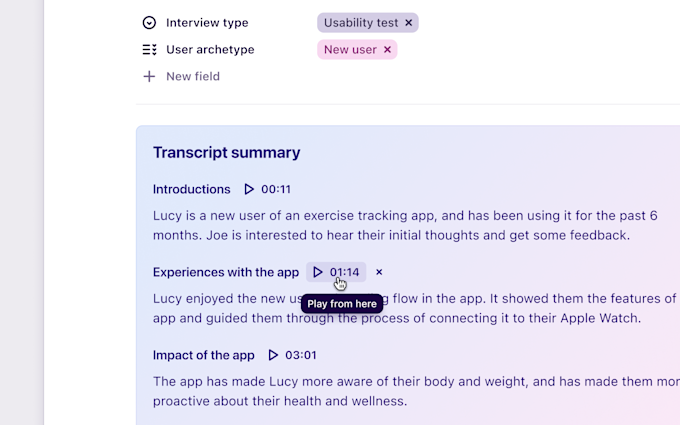
Tips and tricks
Make magic with your customer data in Dovetail

Four ways Dovetail helps Product Managers master continuous product discovery
Events and videos
© Dovetail Research Pty. Ltd.
What is case study research?
Last updated
8 February 2023
Reviewed by
Cathy Heath
Suppose a company receives a spike in the number of customer complaints, or medical experts discover an outbreak of illness affecting children but are not quite sure of the reason. In both cases, carrying out a case study could be the best way to get answers.
Organization
Case studies can be carried out across different disciplines, including education, medicine, sociology, and business.
Most case studies employ qualitative methods, but quantitative methods can also be used. Researchers can then describe, compare, evaluate, and identify patterns or cause-and-effect relationships between the various variables under study. They can then use this knowledge to decide what action to take.
Another thing to note is that case studies are generally singular in their focus. This means they narrow focus to a particular area, making them highly subjective. You cannot always generalize the results of a case study and apply them to a larger population. However, they are valuable tools to illustrate a principle or develop a thesis.
Analyze case study research
Dovetail streamlines case study research to help you uncover and share actionable insights
- What are the different types of case study designs?
Researchers can choose from a variety of case study designs. The design they choose is dependent on what questions they need to answer, the context of the research environment, how much data they already have, and what resources are available.
Here are the common types of case study design:
Explanatory
An explanatory case study is an initial explanation of the how or why that is behind something. This design is commonly used when studying a real-life phenomenon or event. Once the organization understands the reasons behind a phenomenon, it can then make changes to enhance or eliminate the variables causing it.
Here is an example: How is co-teaching implemented in elementary schools? The title for a case study of this subject could be “Case Study of the Implementation of Co-Teaching in Elementary Schools.”
Descriptive
An illustrative or descriptive case study helps researchers shed light on an unfamiliar object or subject after a period of time. The case study provides an in-depth review of the issue at hand and adds real-world examples in the area the researcher wants the audience to understand.
The researcher makes no inferences or causal statements about the object or subject under review. This type of design is often used to understand cultural shifts.
Here is an example: How did people cope with the 2004 Indian Ocean Tsunami? This case study could be titled "A Case Study of the 2004 Indian Ocean Tsunami and its Effect on the Indonesian Population."
Exploratory
Exploratory research is also called a pilot case study. It is usually the first step within a larger research project, often relying on questionnaires and surveys . Researchers use exploratory research to help narrow down their focus, define parameters, draft a specific research question , and/or identify variables in a larger study. This research design usually covers a wider area than others, and focuses on the ‘what’ and ‘who’ of a topic.
Here is an example: How do nutrition and socialization in early childhood affect learning in children? The title of the exploratory study may be “Case Study of the Effects of Nutrition and Socialization on Learning in Early Childhood.”
An intrinsic case study is specifically designed to look at a unique and special phenomenon. At the start of the study, the researcher defines the phenomenon and the uniqueness that differentiates it from others.
In this case, researchers do not attempt to generalize, compare, or challenge the existing assumptions. Instead, they explore the unique variables to enhance understanding. Here is an example: “Case Study of Volcanic Lightning.”
This design can also be identified as a cumulative case study. It uses information from past studies or observations of groups of people in certain settings as the foundation of the new study. Given that it takes multiple areas into account, it allows for greater generalization than a single case study.
The researchers also get an in-depth look at a particular subject from different viewpoints. Here is an example: “Case Study of how PTSD affected Vietnam and Gulf War Veterans Differently Due to Advances in Military Technology.”
Critical instance
A critical case study incorporates both explanatory and intrinsic study designs. It does not have predetermined purposes beyond an investigation of the said subject. It can be used for a deeper explanation of the cause-and-effect relationship. It can also be used to question a common assumption or myth.
The findings can then be used further to generalize whether they would also apply in a different environment. Here is an example: “What Effect Does Prolonged Use of Social Media Have on the Mind of American Youth?”
Instrumental
Instrumental research attempts to achieve goals beyond understanding the object at hand. Researchers explore a larger subject through different, separate studies and use the findings to understand its relationship to another subject. This type of design also provides insight into an issue or helps refine a theory.
For example, you may want to determine if violent behavior in children predisposes them to crime later in life. The focus is on the relationship between children and violent behavior, and why certain children do become violent. Here is an example: “Violence Breeds Violence: Childhood Exposure and Participation in Adult Crime.”
Evaluation case study design is employed to research the effects of a program, policy, or intervention, and assess its effectiveness and impact on future decision-making.
For example, you might want to see whether children learn times tables quicker through an educational game on their iPad versus a more teacher-led intervention. Here is an example: “An Investigation of the Impact of an iPad Multiplication Game for Primary School Children.”
- When do you use case studies?
Case studies are ideal when you want to gain a contextual, concrete, or in-depth understanding of a particular subject. It helps you understand the characteristics, implications, and meanings of the subject.
They are also an excellent choice for those writing a thesis or dissertation, as they help keep the project focused on a particular area when resources or time may be too limited to cover a wider one. You may have to conduct several case studies to explore different aspects of the subject in question and understand the problem.
- What are the steps to follow when conducting a case study?
1. Select a case
Once you identify the problem at hand and come up with questions, identify the case you will focus on. The study can provide insights into the subject at hand, challenge existing assumptions, propose a course of action, and/or open up new areas for further research.
2. Create a theoretical framework
While you will be focusing on a specific detail, the case study design you choose should be linked to existing knowledge on the topic. This prevents it from becoming an isolated description and allows for enhancing the existing information.
It may expand the current theory by bringing up new ideas or concepts, challenge established assumptions, or exemplify a theory by exploring how it answers the problem at hand. A theoretical framework starts with a literature review of the sources relevant to the topic in focus. This helps in identifying key concepts to guide analysis and interpretation.
3. Collect the data
Case studies are frequently supplemented with qualitative data such as observations, interviews, and a review of both primary and secondary sources such as official records, news articles, and photographs. There may also be quantitative data —this data assists in understanding the case thoroughly.
4. Analyze your case
The results of the research depend on the research design. Most case studies are structured with chapters or topic headings for easy explanation and presentation. Others may be written as narratives to allow researchers to explore various angles of the topic and analyze its meanings and implications.
In all areas, always give a detailed contextual understanding of the case and connect it to the existing theory and literature before discussing how it fits into your problem area.
- What are some case study examples?
What are the best approaches for introducing our product into the Kenyan market?
How does the change in marketing strategy aid in increasing the sales volumes of product Y?
How can teachers enhance student participation in classrooms?
How does poverty affect literacy levels in children?
Case study topics
Case study of product marketing strategies in the Kenyan market
Case study of the effects of a marketing strategy change on product Y sales volumes
Case study of X school teachers that encourage active student participation in the classroom
Case study of the effects of poverty on literacy levels in children
Get started today
Go from raw data to valuable insights with a flexible research platform
Editor’s picks
Last updated: 21 December 2023
Last updated: 16 December 2023
Last updated: 6 October 2023
Last updated: 17 February 2024
Last updated: 5 March 2024
Last updated: 19 November 2023
Last updated: 15 February 2024
Last updated: 11 March 2024
Last updated: 12 December 2023
Last updated: 6 March 2024
Last updated: 10 April 2023
Last updated: 20 December 2023
Latest articles
Related topics, log in or sign up.
Get started for free
Organizing Your Social Sciences Research Assignments
- Annotated Bibliography
- Analyzing a Scholarly Journal Article
- Group Presentations
- Dealing with Nervousness
- Using Visual Aids
- Grading Someone Else's Paper
- Types of Structured Group Activities
- Group Project Survival Skills
- Leading a Class Discussion
- Multiple Book Review Essay
- Reviewing Collected Works
- Writing a Case Analysis Paper
- Writing a Case Study
- About Informed Consent
- Writing Field Notes
- Writing a Policy Memo
- Writing a Reflective Paper
- Writing a Research Proposal
- Generative AI and Writing
- Acknowledgments
A case study research paper examines a person, place, event, condition, phenomenon, or other type of subject of analysis in order to extrapolate key themes and results that help predict future trends, illuminate previously hidden issues that can be applied to practice, and/or provide a means for understanding an important research problem with greater clarity. A case study research paper usually examines a single subject of analysis, but case study papers can also be designed as a comparative investigation that shows relationships between two or more subjects. The methods used to study a case can rest within a quantitative, qualitative, or mixed-method investigative paradigm.
Case Studies. Writing@CSU. Colorado State University; Mills, Albert J. , Gabrielle Durepos, and Eiden Wiebe, editors. Encyclopedia of Case Study Research . Thousand Oaks, CA: SAGE Publications, 2010 ; “What is a Case Study?” In Swanborn, Peter G. Case Study Research: What, Why and How? London: SAGE, 2010.
How to Approach Writing a Case Study Research Paper
General information about how to choose a topic to investigate can be found under the " Choosing a Research Problem " tab in the Organizing Your Social Sciences Research Paper writing guide. Review this page because it may help you identify a subject of analysis that can be investigated using a case study design.
However, identifying a case to investigate involves more than choosing the research problem . A case study encompasses a problem contextualized around the application of in-depth analysis, interpretation, and discussion, often resulting in specific recommendations for action or for improving existing conditions. As Seawright and Gerring note, practical considerations such as time and access to information can influence case selection, but these issues should not be the sole factors used in describing the methodological justification for identifying a particular case to study. Given this, selecting a case includes considering the following:
- The case represents an unusual or atypical example of a research problem that requires more in-depth analysis? Cases often represent a topic that rests on the fringes of prior investigations because the case may provide new ways of understanding the research problem. For example, if the research problem is to identify strategies to improve policies that support girl's access to secondary education in predominantly Muslim nations, you could consider using Azerbaijan as a case study rather than selecting a more obvious nation in the Middle East. Doing so may reveal important new insights into recommending how governments in other predominantly Muslim nations can formulate policies that support improved access to education for girls.
- The case provides important insight or illuminate a previously hidden problem? In-depth analysis of a case can be based on the hypothesis that the case study will reveal trends or issues that have not been exposed in prior research or will reveal new and important implications for practice. For example, anecdotal evidence may suggest drug use among homeless veterans is related to their patterns of travel throughout the day. Assuming prior studies have not looked at individual travel choices as a way to study access to illicit drug use, a case study that observes a homeless veteran could reveal how issues of personal mobility choices facilitate regular access to illicit drugs. Note that it is important to conduct a thorough literature review to ensure that your assumption about the need to reveal new insights or previously hidden problems is valid and evidence-based.
- The case challenges and offers a counter-point to prevailing assumptions? Over time, research on any given topic can fall into a trap of developing assumptions based on outdated studies that are still applied to new or changing conditions or the idea that something should simply be accepted as "common sense," even though the issue has not been thoroughly tested in current practice. A case study analysis may offer an opportunity to gather evidence that challenges prevailing assumptions about a research problem and provide a new set of recommendations applied to practice that have not been tested previously. For example, perhaps there has been a long practice among scholars to apply a particular theory in explaining the relationship between two subjects of analysis. Your case could challenge this assumption by applying an innovative theoretical framework [perhaps borrowed from another discipline] to explore whether this approach offers new ways of understanding the research problem. Taking a contrarian stance is one of the most important ways that new knowledge and understanding develops from existing literature.
- The case provides an opportunity to pursue action leading to the resolution of a problem? Another way to think about choosing a case to study is to consider how the results from investigating a particular case may result in findings that reveal ways in which to resolve an existing or emerging problem. For example, studying the case of an unforeseen incident, such as a fatal accident at a railroad crossing, can reveal hidden issues that could be applied to preventative measures that contribute to reducing the chance of accidents in the future. In this example, a case study investigating the accident could lead to a better understanding of where to strategically locate additional signals at other railroad crossings so as to better warn drivers of an approaching train, particularly when visibility is hindered by heavy rain, fog, or at night.
- The case offers a new direction in future research? A case study can be used as a tool for an exploratory investigation that highlights the need for further research about the problem. A case can be used when there are few studies that help predict an outcome or that establish a clear understanding about how best to proceed in addressing a problem. For example, after conducting a thorough literature review [very important!], you discover that little research exists showing the ways in which women contribute to promoting water conservation in rural communities of east central Africa. A case study of how women contribute to saving water in a rural village of Uganda can lay the foundation for understanding the need for more thorough research that documents how women in their roles as cooks and family caregivers think about water as a valuable resource within their community. This example of a case study could also point to the need for scholars to build new theoretical frameworks around the topic [e.g., applying feminist theories of work and family to the issue of water conservation].
Eisenhardt, Kathleen M. “Building Theories from Case Study Research.” Academy of Management Review 14 (October 1989): 532-550; Emmel, Nick. Sampling and Choosing Cases in Qualitative Research: A Realist Approach . Thousand Oaks, CA: SAGE Publications, 2013; Gerring, John. “What Is a Case Study and What Is It Good for?” American Political Science Review 98 (May 2004): 341-354; Mills, Albert J. , Gabrielle Durepos, and Eiden Wiebe, editors. Encyclopedia of Case Study Research . Thousand Oaks, CA: SAGE Publications, 2010; Seawright, Jason and John Gerring. "Case Selection Techniques in Case Study Research." Political Research Quarterly 61 (June 2008): 294-308.
Structure and Writing Style
The purpose of a paper in the social sciences designed around a case study is to thoroughly investigate a subject of analysis in order to reveal a new understanding about the research problem and, in so doing, contributing new knowledge to what is already known from previous studies. In applied social sciences disciplines [e.g., education, social work, public administration, etc.], case studies may also be used to reveal best practices, highlight key programs, or investigate interesting aspects of professional work.
In general, the structure of a case study research paper is not all that different from a standard college-level research paper. However, there are subtle differences you should be aware of. Here are the key elements to organizing and writing a case study research paper.
I. Introduction
As with any research paper, your introduction should serve as a roadmap for your readers to ascertain the scope and purpose of your study . The introduction to a case study research paper, however, should not only describe the research problem and its significance, but you should also succinctly describe why the case is being used and how it relates to addressing the problem. The two elements should be linked. With this in mind, a good introduction answers these four questions:
- What is being studied? Describe the research problem and describe the subject of analysis [the case] you have chosen to address the problem. Explain how they are linked and what elements of the case will help to expand knowledge and understanding about the problem.
- Why is this topic important to investigate? Describe the significance of the research problem and state why a case study design and the subject of analysis that the paper is designed around is appropriate in addressing the problem.
- What did we know about this topic before I did this study? Provide background that helps lead the reader into the more in-depth literature review to follow. If applicable, summarize prior case study research applied to the research problem and why it fails to adequately address the problem. Describe why your case will be useful. If no prior case studies have been used to address the research problem, explain why you have selected this subject of analysis.
- How will this study advance new knowledge or new ways of understanding? Explain why your case study will be suitable in helping to expand knowledge and understanding about the research problem.
Each of these questions should be addressed in no more than a few paragraphs. Exceptions to this can be when you are addressing a complex research problem or subject of analysis that requires more in-depth background information.
II. Literature Review
The literature review for a case study research paper is generally structured the same as it is for any college-level research paper. The difference, however, is that the literature review is focused on providing background information and enabling historical interpretation of the subject of analysis in relation to the research problem the case is intended to address . This includes synthesizing studies that help to:
- Place relevant works in the context of their contribution to understanding the case study being investigated . This would involve summarizing studies that have used a similar subject of analysis to investigate the research problem. If there is literature using the same or a very similar case to study, you need to explain why duplicating past research is important [e.g., conditions have changed; prior studies were conducted long ago, etc.].
- Describe the relationship each work has to the others under consideration that informs the reader why this case is applicable . Your literature review should include a description of any works that support using the case to investigate the research problem and the underlying research questions.
- Identify new ways to interpret prior research using the case study . If applicable, review any research that has examined the research problem using a different research design. Explain how your use of a case study design may reveal new knowledge or a new perspective or that can redirect research in an important new direction.
- Resolve conflicts amongst seemingly contradictory previous studies . This refers to synthesizing any literature that points to unresolved issues of concern about the research problem and describing how the subject of analysis that forms the case study can help resolve these existing contradictions.
- Point the way in fulfilling a need for additional research . Your review should examine any literature that lays a foundation for understanding why your case study design and the subject of analysis around which you have designed your study may reveal a new way of approaching the research problem or offer a perspective that points to the need for additional research.
- Expose any gaps that exist in the literature that the case study could help to fill . Summarize any literature that not only shows how your subject of analysis contributes to understanding the research problem, but how your case contributes to a new way of understanding the problem that prior research has failed to do.
- Locate your own research within the context of existing literature [very important!] . Collectively, your literature review should always place your case study within the larger domain of prior research about the problem. The overarching purpose of reviewing pertinent literature in a case study paper is to demonstrate that you have thoroughly identified and synthesized prior studies in relation to explaining the relevance of the case in addressing the research problem.
III. Method
In this section, you explain why you selected a particular case [i.e., subject of analysis] and the strategy you used to identify and ultimately decide that your case was appropriate in addressing the research problem. The way you describe the methods used varies depending on the type of subject of analysis that constitutes your case study.
If your subject of analysis is an incident or event . In the social and behavioral sciences, the event or incident that represents the case to be studied is usually bounded by time and place, with a clear beginning and end and with an identifiable location or position relative to its surroundings. The subject of analysis can be a rare or critical event or it can focus on a typical or regular event. The purpose of studying a rare event is to illuminate new ways of thinking about the broader research problem or to test a hypothesis. Critical incident case studies must describe the method by which you identified the event and explain the process by which you determined the validity of this case to inform broader perspectives about the research problem or to reveal new findings. However, the event does not have to be a rare or uniquely significant to support new thinking about the research problem or to challenge an existing hypothesis. For example, Walo, Bull, and Breen conducted a case study to identify and evaluate the direct and indirect economic benefits and costs of a local sports event in the City of Lismore, New South Wales, Australia. The purpose of their study was to provide new insights from measuring the impact of a typical local sports event that prior studies could not measure well because they focused on large "mega-events." Whether the event is rare or not, the methods section should include an explanation of the following characteristics of the event: a) when did it take place; b) what were the underlying circumstances leading to the event; and, c) what were the consequences of the event in relation to the research problem.
If your subject of analysis is a person. Explain why you selected this particular individual to be studied and describe what experiences they have had that provide an opportunity to advance new understandings about the research problem. Mention any background about this person which might help the reader understand the significance of their experiences that make them worthy of study. This includes describing the relationships this person has had with other people, institutions, and/or events that support using them as the subject for a case study research paper. It is particularly important to differentiate the person as the subject of analysis from others and to succinctly explain how the person relates to examining the research problem [e.g., why is one politician in a particular local election used to show an increase in voter turnout from any other candidate running in the election]. Note that these issues apply to a specific group of people used as a case study unit of analysis [e.g., a classroom of students].
If your subject of analysis is a place. In general, a case study that investigates a place suggests a subject of analysis that is unique or special in some way and that this uniqueness can be used to build new understanding or knowledge about the research problem. A case study of a place must not only describe its various attributes relevant to the research problem [e.g., physical, social, historical, cultural, economic, political], but you must state the method by which you determined that this place will illuminate new understandings about the research problem. It is also important to articulate why a particular place as the case for study is being used if similar places also exist [i.e., if you are studying patterns of homeless encampments of veterans in open spaces, explain why you are studying Echo Park in Los Angeles rather than Griffith Park?]. If applicable, describe what type of human activity involving this place makes it a good choice to study [e.g., prior research suggests Echo Park has more homeless veterans].
If your subject of analysis is a phenomenon. A phenomenon refers to a fact, occurrence, or circumstance that can be studied or observed but with the cause or explanation to be in question. In this sense, a phenomenon that forms your subject of analysis can encompass anything that can be observed or presumed to exist but is not fully understood. In the social and behavioral sciences, the case usually focuses on human interaction within a complex physical, social, economic, cultural, or political system. For example, the phenomenon could be the observation that many vehicles used by ISIS fighters are small trucks with English language advertisements on them. The research problem could be that ISIS fighters are difficult to combat because they are highly mobile. The research questions could be how and by what means are these vehicles used by ISIS being supplied to the militants and how might supply lines to these vehicles be cut off? How might knowing the suppliers of these trucks reveal larger networks of collaborators and financial support? A case study of a phenomenon most often encompasses an in-depth analysis of a cause and effect that is grounded in an interactive relationship between people and their environment in some way.
NOTE: The choice of the case or set of cases to study cannot appear random. Evidence that supports the method by which you identified and chose your subject of analysis should clearly support investigation of the research problem and linked to key findings from your literature review. Be sure to cite any studies that helped you determine that the case you chose was appropriate for examining the problem.
IV. Discussion
The main elements of your discussion section are generally the same as any research paper, but centered around interpreting and drawing conclusions about the key findings from your analysis of the case study. Note that a general social sciences research paper may contain a separate section to report findings. However, in a paper designed around a case study, it is common to combine a description of the results with the discussion about their implications. The objectives of your discussion section should include the following:
Reiterate the Research Problem/State the Major Findings Briefly reiterate the research problem you are investigating and explain why the subject of analysis around which you designed the case study were used. You should then describe the findings revealed from your study of the case using direct, declarative, and succinct proclamation of the study results. Highlight any findings that were unexpected or especially profound.
Explain the Meaning of the Findings and Why They are Important Systematically explain the meaning of your case study findings and why you believe they are important. Begin this part of the section by repeating what you consider to be your most important or surprising finding first, then systematically review each finding. Be sure to thoroughly extrapolate what your analysis of the case can tell the reader about situations or conditions beyond the actual case that was studied while, at the same time, being careful not to misconstrue or conflate a finding that undermines the external validity of your conclusions.
Relate the Findings to Similar Studies No study in the social sciences is so novel or possesses such a restricted focus that it has absolutely no relation to previously published research. The discussion section should relate your case study results to those found in other studies, particularly if questions raised from prior studies served as the motivation for choosing your subject of analysis. This is important because comparing and contrasting the findings of other studies helps support the overall importance of your results and it highlights how and in what ways your case study design and the subject of analysis differs from prior research about the topic.
Consider Alternative Explanations of the Findings Remember that the purpose of social science research is to discover and not to prove. When writing the discussion section, you should carefully consider all possible explanations revealed by the case study results, rather than just those that fit your hypothesis or prior assumptions and biases. Be alert to what the in-depth analysis of the case may reveal about the research problem, including offering a contrarian perspective to what scholars have stated in prior research if that is how the findings can be interpreted from your case.
Acknowledge the Study's Limitations You can state the study's limitations in the conclusion section of your paper but describing the limitations of your subject of analysis in the discussion section provides an opportunity to identify the limitations and explain why they are not significant. This part of the discussion section should also note any unanswered questions or issues your case study could not address. More detailed information about how to document any limitations to your research can be found here .
Suggest Areas for Further Research Although your case study may offer important insights about the research problem, there are likely additional questions related to the problem that remain unanswered or findings that unexpectedly revealed themselves as a result of your in-depth analysis of the case. Be sure that the recommendations for further research are linked to the research problem and that you explain why your recommendations are valid in other contexts and based on the original assumptions of your study.
V. Conclusion
As with any research paper, you should summarize your conclusion in clear, simple language; emphasize how the findings from your case study differs from or supports prior research and why. Do not simply reiterate the discussion section. Provide a synthesis of key findings presented in the paper to show how these converge to address the research problem. If you haven't already done so in the discussion section, be sure to document the limitations of your case study and any need for further research.
The function of your paper's conclusion is to: 1) reiterate the main argument supported by the findings from your case study; 2) state clearly the context, background, and necessity of pursuing the research problem using a case study design in relation to an issue, controversy, or a gap found from reviewing the literature; and, 3) provide a place to persuasively and succinctly restate the significance of your research problem, given that the reader has now been presented with in-depth information about the topic.
Consider the following points to help ensure your conclusion is appropriate:
- If the argument or purpose of your paper is complex, you may need to summarize these points for your reader.
- If prior to your conclusion, you have not yet explained the significance of your findings or if you are proceeding inductively, use the conclusion of your paper to describe your main points and explain their significance.
- Move from a detailed to a general level of consideration of the case study's findings that returns the topic to the context provided by the introduction or within a new context that emerges from your case study findings.
Note that, depending on the discipline you are writing in or the preferences of your professor, the concluding paragraph may contain your final reflections on the evidence presented as it applies to practice or on the essay's central research problem. However, the nature of being introspective about the subject of analysis you have investigated will depend on whether you are explicitly asked to express your observations in this way.
Problems to Avoid
Overgeneralization One of the goals of a case study is to lay a foundation for understanding broader trends and issues applied to similar circumstances. However, be careful when drawing conclusions from your case study. They must be evidence-based and grounded in the results of the study; otherwise, it is merely speculation. Looking at a prior example, it would be incorrect to state that a factor in improving girls access to education in Azerbaijan and the policy implications this may have for improving access in other Muslim nations is due to girls access to social media if there is no documentary evidence from your case study to indicate this. There may be anecdotal evidence that retention rates were better for girls who were engaged with social media, but this observation would only point to the need for further research and would not be a definitive finding if this was not a part of your original research agenda.
Failure to Document Limitations No case is going to reveal all that needs to be understood about a research problem. Therefore, just as you have to clearly state the limitations of a general research study , you must describe the specific limitations inherent in the subject of analysis. For example, the case of studying how women conceptualize the need for water conservation in a village in Uganda could have limited application in other cultural contexts or in areas where fresh water from rivers or lakes is plentiful and, therefore, conservation is understood more in terms of managing access rather than preserving access to a scarce resource.
Failure to Extrapolate All Possible Implications Just as you don't want to over-generalize from your case study findings, you also have to be thorough in the consideration of all possible outcomes or recommendations derived from your findings. If you do not, your reader may question the validity of your analysis, particularly if you failed to document an obvious outcome from your case study research. For example, in the case of studying the accident at the railroad crossing to evaluate where and what types of warning signals should be located, you failed to take into consideration speed limit signage as well as warning signals. When designing your case study, be sure you have thoroughly addressed all aspects of the problem and do not leave gaps in your analysis that leave the reader questioning the results.
Case Studies. Writing@CSU. Colorado State University; Gerring, John. Case Study Research: Principles and Practices . New York: Cambridge University Press, 2007; Merriam, Sharan B. Qualitative Research and Case Study Applications in Education . Rev. ed. San Francisco, CA: Jossey-Bass, 1998; Miller, Lisa L. “The Use of Case Studies in Law and Social Science Research.” Annual Review of Law and Social Science 14 (2018): TBD; Mills, Albert J., Gabrielle Durepos, and Eiden Wiebe, editors. Encyclopedia of Case Study Research . Thousand Oaks, CA: SAGE Publications, 2010; Putney, LeAnn Grogan. "Case Study." In Encyclopedia of Research Design , Neil J. Salkind, editor. (Thousand Oaks, CA: SAGE Publications, 2010), pp. 116-120; Simons, Helen. Case Study Research in Practice . London: SAGE Publications, 2009; Kratochwill, Thomas R. and Joel R. Levin, editors. Single-Case Research Design and Analysis: New Development for Psychology and Education . Hilldsale, NJ: Lawrence Erlbaum Associates, 1992; Swanborn, Peter G. Case Study Research: What, Why and How? London : SAGE, 2010; Yin, Robert K. Case Study Research: Design and Methods . 6th edition. Los Angeles, CA, SAGE Publications, 2014; Walo, Maree, Adrian Bull, and Helen Breen. “Achieving Economic Benefits at Local Events: A Case Study of a Local Sports Event.” Festival Management and Event Tourism 4 (1996): 95-106.
Writing Tip
At Least Five Misconceptions about Case Study Research
Social science case studies are often perceived as limited in their ability to create new knowledge because they are not randomly selected and findings cannot be generalized to larger populations. Flyvbjerg examines five misunderstandings about case study research and systematically "corrects" each one. To quote, these are:
Misunderstanding 1 : General, theoretical [context-independent] knowledge is more valuable than concrete, practical [context-dependent] knowledge. Misunderstanding 2 : One cannot generalize on the basis of an individual case; therefore, the case study cannot contribute to scientific development. Misunderstanding 3 : The case study is most useful for generating hypotheses; that is, in the first stage of a total research process, whereas other methods are more suitable for hypotheses testing and theory building. Misunderstanding 4 : The case study contains a bias toward verification, that is, a tendency to confirm the researcher’s preconceived notions. Misunderstanding 5 : It is often difficult to summarize and develop general propositions and theories on the basis of specific case studies [p. 221].
While writing your paper, think introspectively about how you addressed these misconceptions because to do so can help you strengthen the validity and reliability of your research by clarifying issues of case selection, the testing and challenging of existing assumptions, the interpretation of key findings, and the summation of case outcomes. Think of a case study research paper as a complete, in-depth narrative about the specific properties and key characteristics of your subject of analysis applied to the research problem.
Flyvbjerg, Bent. “Five Misunderstandings About Case-Study Research.” Qualitative Inquiry 12 (April 2006): 219-245.
- << Previous: Writing a Case Analysis Paper
- Next: Writing a Field Report >>
- Last Updated: Mar 6, 2024 1:00 PM
- URL: https://libguides.usc.edu/writingguide/assignments
- Affiliate Program

- UNITED STATES
- 台灣 (TAIWAN)
- TÜRKIYE (TURKEY)
- Academic Editing Services
- - Research Paper
- - Journal Manuscript
- - Dissertation
- - College & University Assignments
- Admissions Editing Services
- - Application Essay
- - Personal Statement
- - Recommendation Letter
- - Cover Letter
- - CV/Resume
- Business Editing Services
- - Business Documents
- - Report & Brochure
- - Website & Blog
- Writer Editing Services
- - Script & Screenplay
- Our Editors
- Client Reviews
- Editing & Proofreading Prices
- Wordvice Points
- Partner Discount
- Plagiarism Checker
- APA Citation Generator
- MLA Citation Generator
- Chicago Citation Generator
- Vancouver Citation Generator
- - APA Style
- - MLA Style
- - Chicago Style
- - Vancouver Style
- Writing & Editing Guide
- Academic Resources
- Admissions Resources
How to Write a Case Study | Examples & Methods
What is a case study?
A case study is a research approach that provides an in-depth examination of a particular phenomenon, event, organization, or individual. It involves analyzing and interpreting data to provide a comprehensive understanding of the subject under investigation.
Case studies can be used in various disciplines, including business, social sciences, medicine ( clinical case report ), engineering, and education. The aim of a case study is to provide an in-depth exploration of a specific subject, often with the goal of generating new insights into the phenomena being studied.
When to write a case study
Case studies are often written to present the findings of an empirical investigation or to illustrate a particular point or theory. They are useful when researchers want to gain an in-depth understanding of a specific phenomenon or when they are interested in exploring new areas of inquiry.
Case studies are also useful when the subject of the research is rare or when the research question is complex and requires an in-depth examination. A case study can be a good fit for a thesis or dissertation as well.
Case study examples
Below are some examples of case studies with their research questions:
These examples demonstrate the diversity of research questions and case studies that can be explored. From studying small businesses in Ghana to the ethical issues in supply chains, case studies can be used to explore a wide range of phenomena.
Outlying cases vs. representative cases
An outlying case stud y refers to a case that is unusual or deviates significantly from the norm. An example of an outlying case study could be a small, family-run bed and breakfast that was able to survive and even thrive during the COVID-19 pandemic, while other larger hotels struggled to stay afloat.
On the other hand, a representative case study refers to a case that is typical of the phenomenon being studied. An example of a representative case study could be a hotel chain that operates in multiple locations that faced significant challenges during the COVID-19 pandemic, such as reduced demand for hotel rooms, increased safety and health protocols, and supply chain disruptions. The hotel chain case could be representative of the broader hospitality industry during the pandemic, and thus provides an insight into the typical challenges that businesses in the industry faced.
Steps for Writing a Case Study
As with any academic paper, writing a case study requires careful preparation and research before a single word of the document is ever written. Follow these basic steps to ensure that you don’t miss any crucial details when composing your case study.
Step 1: Select a case to analyze
After you have developed your statement of the problem and research question , the first step in writing a case study is to select a case that is representative of the phenomenon being investigated or that provides an outlier. For example, if a researcher wants to explore the impact of COVID-19 on the hospitality industry, they could select a representative case, such as a hotel chain that operates in multiple locations, or an outlying case, such as a small bed and breakfast that was able to pivot their business model to survive during the pandemic. Selecting the appropriate case is critical in ensuring the research question is adequately explored.
Step 2: Create a theoretical framework
Theoretical frameworks are used to guide the analysis and interpretation of data in a case study. The framework should provide a clear explanation of the key concepts, variables, and relationships that are relevant to the research question. The theoretical framework can be drawn from existing literature, or the researcher can develop their own framework based on the data collected. The theoretical framework should be developed early in the research process to guide the data collection and analysis.
To give your case analysis a strong theoretical grounding, be sure to include a literature review of references and sources relating to your topic and develop a clear theoretical framework. Your case study does not simply stand on its own but interacts with other studies related to your topic. Your case study can do one of the following:
- Demonstrate a theory by showing how it explains the case being investigated
- Broaden a theory by identifying additional concepts and ideas that can be incorporated to strengthen it
- Confront a theory via an outlier case that does not conform to established conclusions or assumptions
Step 3: Collect data for your case study
Data collection can involve a variety of research methods , including interviews, surveys, observations, and document analyses, and it can include both primary and secondary sources . It is essential to ensure that the data collected is relevant to the research question and that it is collected in a systematic and ethical manner. Data collection methods should be chosen based on the research question and the availability of data. It is essential to plan data collection carefully to ensure that the data collected is of high quality
Step 4: Describe the case and analyze the details
The final step is to describe the case in detail and analyze the data collected. This involves identifying patterns and themes that emerge from the data and drawing conclusions that are relevant to the research question. It is essential to ensure that the analysis is supported by the data and that any limitations or alternative explanations are acknowledged.
The manner in which you report your findings depends on the type of research you are doing. Some case studies are structured like a standard academic paper, with separate sections or chapters for the methods section , results section , and discussion section , while others are structured more like a standalone literature review.
Regardless of the topic you choose to pursue, writing a case study requires a systematic and rigorous approach to data collection and analysis. By following the steps outlined above and using examples from existing literature, researchers can create a comprehensive and insightful case study that contributes to the understanding of a particular phenomenon.
Preparing Your Case Study for Publication
After completing the draft of your case study, be sure to revise and edit your work for any mistakes, including grammatical errors , punctuation errors , spelling mistakes, and awkward sentence structure . Ensure that your case study is well-structured and that your arguments are well-supported with language that follows the conventions of academic writing . To ensure your work is polished for style and free of errors, get English editing services from Wordvice, including our paper editing services and manuscript editing services . Let our academic subject experts enhance the style and flow of your academic work so you can submit your case study with confidence.

Research Writing and Analysis
- NVivo Group and Study Sessions
- SPSS This link opens in a new window
- Statistical Analysis Group sessions
- Using Qualtrics
- Dissertation and Data Analysis Group Sessions
- Research Process Flow Chart
- Research Alignment This link opens in a new window
- Step 1: Seek Out Evidence
- Step 2: Explain
- Step 3: The Big Picture
- Step 4: Own It
- Step 5: Illustrate
- Annotated Bibliography
- Literature Review This link opens in a new window
- Systematic Reviews & Meta-Analyses
- How to Synthesize and Analyze
- Synthesis and Analysis Practice
- Synthesis and Analysis Group Sessions
- Problem Statement
- Purpose Statement
- Quantitative Research Questions
- Qualitative Research Questions
- Trustworthiness of Qualitative Data
- Analysis and Coding Example- Qualitative Data
- Thematic Data Analysis in Qualitative Design
- Dissertation to Journal Article This link opens in a new window
- International Journal of Online Graduate Education (IJOGE) This link opens in a new window
- Journal of Research in Innovative Teaching & Learning (JRIT&L) This link opens in a new window
Writing a Case Study

What is a case study?

A Case study is:
- An in-depth research design that primarily uses a qualitative methodology but sometimes includes quantitative methodology.
- Used to examine an identifiable problem confirmed through research.
- Used to investigate an individual, group of people, organization, or event.
- Used to mostly answer "how" and "why" questions.
What are the different types of case studies?

Note: These are the primary case studies. As you continue to research and learn
about case studies you will begin to find a robust list of different types.
Who are your case study participants?

What is triangulation ?
Validity and credibility are an essential part of the case study. Therefore, the researcher should include triangulation to ensure trustworthiness while accurately reflecting what the researcher seeks to investigate.

How to write a Case Study?
When developing a case study, there are different ways you could present the information, but remember to include the five parts for your case study.

Was this resource helpful?
- << Previous: Thematic Data Analysis in Qualitative Design
- Next: Journal Article Reporting Standards (JARS) >>
- Last Updated: Apr 2, 2024 6:35 PM
- URL: https://resources.nu.edu/researchtools

- How it works
A Quick Guide to Case Study with Examples
Published by Alvin Nicolas at August 14th, 2021 , Revised On August 29, 2023
A case study is a documented history and detailed analysis of a situation concerning organisations, industries, and markets.
A case study:
- Focuses on discovering new facts of the situation under observation.
- Includes data collection from multiple sources over time.
- Widely used in social sciences to study the underlying information, organisation, community, or event.
- It does not provide any solution to the problem .
When to Use Case Study?
You can use a case study in your research when:
- The focus of your study is to find answers to how and why questions .
- You don’t have enough time to conduct extensive research; case studies are convenient for completing your project successfully.
- You want to analyse real-world problems in-depth, then you can use the method of the case study.
You can consider a single case to gain in-depth knowledge about the subject, or you can choose multiple cases to know about various aspects of your research problem .
What are the Aims of the Case Study?
- The case study aims at identifying weak areas that can be improved.
- This method is often used for idiographic research (focuses on individual cases or events).
- Another aim of the case study is nomothetic research (aims to discover new theories through data analysis of multiple cases).
Types of Case Studies
There are different types of case studies that can be categorised based on the purpose of the investigation.
Looking for dissertation help?
Researchprospect to the rescue then.
We have expert writers on our team who are skilled at helping students with dissertations across a variety of STEM disciplines. Guaranteeing 100% satisfaction!

How to Conduct a Case Study?
- Select the Case to Investigate
- Formulate the Research Question
- Review of Literature
- Choose the Precise Case to Use in your Study
- Select Data Collection and Analysis Techniques
- Collect the Data
- Analyse the Data
- Prepare the Report
Step1: Select the Case to Investigate
The first step is to select a case to conduct your investigation. You should remember the following points.
- Make sure that you perform the study in the available timeframe.
- There should not be too much information available about the organisation.
- You should be able to get access to the organisation.
- There should be enough information available about the subject to conduct further research.
Step2: Formulate the Research Question
It’s necessary to formulate a research question to proceed with your case study. Most of the research questions begin with how, why, what, or what can .
You can also use a research statement instead of a research question to conduct your research which can be conditional or non-conditional.
Step 3: Review of Literature
Once you formulate your research statement or question, you need to extensively review the documentation about the existing discoveries related to your research question or statement.
Step 4: Choose the Precise Case to Use in your Study
You need to select a specific case or multiple cases related to your research. It would help if you treated each case individually while using multiple cases. The outcomes of each case can be used as contributors to the outcomes of the entire study. You can select the following cases.
- Representing various geographic regions
- Cases with various size parameters
- Explaining the existing theories or assumptions
- Leading to discoveries
- Providing a base for future research.
Step 5: Select Data Collection and Analysis Techniques
You can choose both qualitative or quantitative approaches for collecting the data . You can use interviews , surveys , artifacts, documentation, newspapers, and photographs, etc. To avoid biased observation, you can triangulate your research to provide different views of your case. Even if you are focusing on a single case, you need to observe various case angles. It would help if you constructed validity, internal and external validity, as well as reliability.
Example: Identifying the impacts of contaminated water on people’s health and the factors responsible for it. You need to gather the data using qualitative and quantitative approaches to understand the case in such cases.
Construct validity: You should select the most suitable measurement tool for your research.
Internal validity: You should use various methodological tools to triangulate the data. Try different methods to study the same hypothesis.
External validity: You need to effectively apply the data beyond the case’s circumstances to more general issues.
Reliability: You need to be confident enough to formulate the new direction for future studies based on your findings.
Also Read: Reliability and Validity
Step 6: Collect the Data
Beware of the following when collecting data:
- Information should be gathered systematically, and the collected evidence from various sources should contribute to your research objectives.
- Don’t collect your data randomly.
- Recheck your research questions to avoid mistakes.
- You should save the collected data in any popular format for clear understanding.
- While making any changes to collecting information, make sure to record the changes in a document.
- You should maintain a case diary and note your opinions and thoughts evolved throughout the study.
Step 7: Analyse the Data
The research data identifies the relationship between the objects of study and the research questions or statements. You need to reconfirm the collected information and tabulate it correctly for better understanding.
Step 8: Prepare the Report
It’s essential to prepare a report for your case study. You can write your case study in the form of a scientific paper or thesis discussing its detail with supporting evidence.
A case study can be represented by incorporating quotations, stories, anecdotes, interview transcripts , etc., with empirical data in the result section.
You can also write it in narrative styles using textual analysis or discourse analysis . Your report should also include evidence from published literature, and you can put it in the discussion section.
Advantages and Disadvantages of Case Study
Frequently asked questions, what is the case study.
A case study is a research method where a specific instance, event, or situation is deeply examined to gain insights into real-world complexities. It involves detailed analysis of context, data, and variables to understand patterns, causes, and effects, often used in various disciplines for in-depth exploration.
You May Also Like
You can transcribe an interview by converting a conversation into a written format including question-answer recording sessions between two or more people.
Descriptive research is carried out to describe current issues, programs, and provides information about the issue through surveys and various fact-finding methods.
Content analysis is used to identify specific words, patterns, concepts, themes, phrases, or sentences within the content in the recorded communication.
USEFUL LINKS
LEARNING RESOURCES

COMPANY DETAILS

- How It Works
Have a language expert improve your writing
Run a free plagiarism check in 10 minutes, automatically generate references for free.
- Knowledge Base
- Methodology
- Case Study | Definition, Examples & Methods
Case Study | Definition, Examples & Methods
Published on 5 May 2022 by Shona McCombes . Revised on 30 January 2023.
A case study is a detailed study of a specific subject, such as a person, group, place, event, organisation, or phenomenon. Case studies are commonly used in social, educational, clinical, and business research.
A case study research design usually involves qualitative methods , but quantitative methods are sometimes also used. Case studies are good for describing , comparing, evaluating, and understanding different aspects of a research problem .
Table of contents
When to do a case study, step 1: select a case, step 2: build a theoretical framework, step 3: collect your data, step 4: describe and analyse the case.
A case study is an appropriate research design when you want to gain concrete, contextual, in-depth knowledge about a specific real-world subject. It allows you to explore the key characteristics, meanings, and implications of the case.
Case studies are often a good choice in a thesis or dissertation . They keep your project focused and manageable when you don’t have the time or resources to do large-scale research.
You might use just one complex case study where you explore a single subject in depth, or conduct multiple case studies to compare and illuminate different aspects of your research problem.
Prevent plagiarism, run a free check.
Once you have developed your problem statement and research questions , you should be ready to choose the specific case that you want to focus on. A good case study should have the potential to:
- Provide new or unexpected insights into the subject
- Challenge or complicate existing assumptions and theories
- Propose practical courses of action to resolve a problem
- Open up new directions for future research
Unlike quantitative or experimental research, a strong case study does not require a random or representative sample. In fact, case studies often deliberately focus on unusual, neglected, or outlying cases which may shed new light on the research problem.
If you find yourself aiming to simultaneously investigate and solve an issue, consider conducting action research . As its name suggests, action research conducts research and takes action at the same time, and is highly iterative and flexible.
However, you can also choose a more common or representative case to exemplify a particular category, experience, or phenomenon.
While case studies focus more on concrete details than general theories, they should usually have some connection with theory in the field. This way the case study is not just an isolated description, but is integrated into existing knowledge about the topic. It might aim to:
- Exemplify a theory by showing how it explains the case under investigation
- Expand on a theory by uncovering new concepts and ideas that need to be incorporated
- Challenge a theory by exploring an outlier case that doesn’t fit with established assumptions
To ensure that your analysis of the case has a solid academic grounding, you should conduct a literature review of sources related to the topic and develop a theoretical framework . This means identifying key concepts and theories to guide your analysis and interpretation.
There are many different research methods you can use to collect data on your subject. Case studies tend to focus on qualitative data using methods such as interviews, observations, and analysis of primary and secondary sources (e.g., newspaper articles, photographs, official records). Sometimes a case study will also collect quantitative data .
The aim is to gain as thorough an understanding as possible of the case and its context.
In writing up the case study, you need to bring together all the relevant aspects to give as complete a picture as possible of the subject.
How you report your findings depends on the type of research you are doing. Some case studies are structured like a standard scientific paper or thesis, with separate sections or chapters for the methods , results , and discussion .
Others are written in a more narrative style, aiming to explore the case from various angles and analyse its meanings and implications (for example, by using textual analysis or discourse analysis ).
In all cases, though, make sure to give contextual details about the case, connect it back to the literature and theory, and discuss how it fits into wider patterns or debates.
Cite this Scribbr article
If you want to cite this source, you can copy and paste the citation or click the ‘Cite this Scribbr article’ button to automatically add the citation to our free Reference Generator.
McCombes, S. (2023, January 30). Case Study | Definition, Examples & Methods. Scribbr. Retrieved 2 April 2024, from https://www.scribbr.co.uk/research-methods/case-studies/
Is this article helpful?
Shona McCombes
Other students also liked, correlational research | guide, design & examples, a quick guide to experimental design | 5 steps & examples, descriptive research design | definition, methods & examples.
Writing A Case Study
Case Study Examples

Brilliant Case Study Examples and Templates For Your Help
15 min read
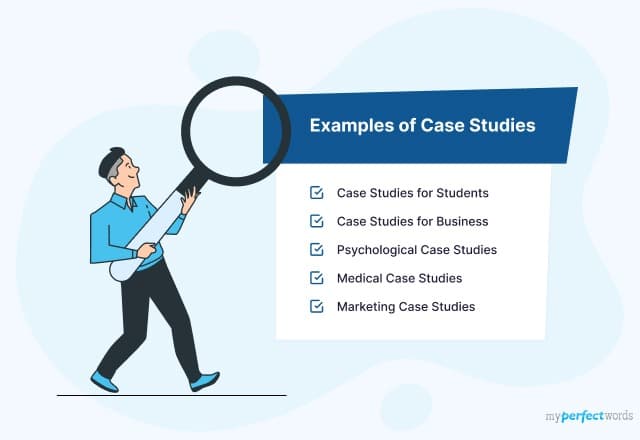
People also read
A Complete Case Study Writing Guide With Examples
Simple Case Study Format for Students to Follow
Understand the Types of Case Study Here
It’s no surprise that writing a case study is one of the most challenging academic tasks for students. You’re definitely not alone here!
Most people don't realize that there are specific guidelines to follow when writing a case study. If you don't know where to start, it's easy to get overwhelmed and give up before you even begin.
Don't worry! Let us help you out!
We've collected over 25 free case study examples with solutions just for you. These samples with solutions will help you win over your panel and score high marks on your case studies.
So, what are you waiting for? Let's dive in and learn the secrets to writing a successful case study.
- 1. An Overview of Case Studies
- 2. Case Study Examples for Students
- 3. Business Case Study Examples
- 4. Medical Case Study Examples
- 5. Psychology Case Study Examples
- 6. Sales Case Study Examples
- 7. Interview Case Study Examples
- 8. Marketing Case Study Examples
- 9. Tips to Write a Good Case Study
An Overview of Case Studies
A case study is a research method used to study a particular individual, group, or situation in depth. It involves analyzing and interpreting data from a variety of sources to gain insight into the subject being studied.
Case studies are often used in psychology, business, and education to explore complicated problems and find solutions. They usually have detailed descriptions of the subject, background info, and an analysis of the main issues.
The goal of a case study is to provide a comprehensive understanding of the subject. Typically, case studies can be divided into three parts, challenges, solutions, and results.
Here is a case study sample PDF so you can have a clearer understanding of what a case study actually is:
Case Study Sample PDF
How to Write a Case Study Examples
Learn how to write a case study with the help of our comprehensive case study guide.
Case Study Examples for Students
Quite often, students are asked to present case studies in their academic journeys. The reason instructors assign case studies is for students to sharpen their critical analysis skills, understand how companies make profits, etc.
Below are some case study examples in research, suitable for students:
Case Study Example in Software Engineering
Qualitative Research Case Study Sample
Software Quality Assurance Case Study
Social Work Case Study Example
Ethical Case Study
Case Study Example PDF
These examples can guide you on how to structure and format your own case studies.
Struggling with formatting your case study? Check this case study format guide and perfect your document’s structure today.
Business Case Study Examples
A business case study examines a business’s specific challenge or goal and how it should be solved. Business case studies usually focus on several details related to the initial challenge and proposed solution.
To help you out, here are some samples so you can create case studies that are related to businesses:
Here are some more business case study examples:
Business Case Studies PDF
Business Case Studies Example
Typically, a business case study discovers one of your customer's stories and how you solved a problem for them. It allows your prospects to see how your solutions address their needs.
Medical Case Study Examples
Medical case studies are an essential part of medical education. They help students to understand how to diagnose and treat patients.
Here are some medical case study examples to help you.
Medical Case Study Example
Nursing Case Study Example
Want to understand the various types of case studies? Check out our types of case study blog to select the perfect type.
Psychology Case Study Examples
Case studies are a great way of investigating individuals with psychological abnormalities. This is why it is a very common assignment in psychology courses.
By examining all the aspects of your subject’s life, you discover the possible causes of exhibiting such behavior.
For your help, here are some interesting psychology case study examples:
Psychology Case Study Example
Mental Health Case Study Example
Sales Case Study Examples
Case studies are important tools for sales teams’ performance improvement. By examining sales successes, teams can gain insights into effective strategies and create action plans to employ similar tactics.
By researching case studies of successful sales campaigns, sales teams can more accurately identify challenges and develop solutions.
Sales Case Study Example
Interview Case Study Examples
Interview case studies provide businesses with invaluable information. This data allows them to make informed decisions related to certain markets or subjects.
Interview Case Study Example
Marketing Case Study Examples
Marketing case studies are real-life stories that showcase how a business solves a problem. They typically discuss how a business achieves a goal using a specific marketing strategy or tactic.
They typically describe a challenge faced by a business, the solution implemented, and the results achieved.
This is a short sample marketing case study for you to get an idea of what an actual marketing case study looks like.
Here are some more popular marketing studies that show how companies use case studies as a means of marketing and promotion:
“Chevrolet Discover the Unexpected” by Carol H. Williams
This case study explores Chevrolet's “ DTU Journalism Fellows ” program. The case study uses the initials “DTU” to generate interest and encourage readers to learn more.
Multiple types of media, such as images and videos, are used to explain the challenges faced. The case study concludes with an overview of the achievements that were met.
Key points from the case study include:
- Using a well-known brand name in the title can create interest.
- Combining different media types, such as headings, images, and videos, can help engage readers and make the content more memorable.
- Providing a summary of the key achievements at the end of the case study can help readers better understand the project's impact.
“The Met” by Fantasy
“ The Met ” by Fantasy is a fictional redesign of the Metropolitan Museum of Art in New York City, created by the design studio Fantasy. The case study clearly and simply showcases the museum's website redesign.
The Met emphasizes the website’s features and interface by showcasing each section of the interface individually, allowing the readers to concentrate on the significant elements.
For those who prefer text, each feature includes an objective description. The case study also includes a “Contact Us” call-to-action at the bottom of the page, inviting visitors to contact the company.
Key points from this “The Met” include:
- Keeping the case study simple and clean can help readers focus on the most important aspects.
- Presenting the features and solutions with a visual showcase can be more effective than writing a lot of text.
- Including a clear call-to-action at the end of the case study can encourage visitors to contact the company for more information.
“Better Experiences for All” by Herman Miller
Herman Miller's minimalist approach to furniture design translates to their case study, “ Better Experiences for All ”, for a Dubai hospital. The page features a captivating video with closed-captioning and expandable text for accessibility.
The case study presents a wealth of information in a concise format, enabling users to grasp the complexities of the strategy with ease. It concludes with a client testimonial and a list of furniture items purchased from the brand.
Key points from the “Better Experiences” include:
- Make sure your case study is user-friendly by including accessibility features like closed captioning and expandable text.
- Include a list of products that were used in the project to guide potential customers.
“NetApp” by Evisort
Evisort's case study on “ NetApp ” stands out for its informative and compelling approach. The study begins with a client-centric overview of NetApp, strategically directing attention to the client rather than the company or team involved.
The case study incorporates client quotes and explores NetApp’s challenges during COVID-19. Evisort showcases its value as a client partner by showing how its services supported NetApp through difficult times.
- Provide an overview of the company in the client’s words, and put focus on the customer.
- Highlight how your services can help clients during challenging times.
- Make your case study accessible by providing it in various formats.
“Red Sox Season Campaign,” by CTP Boston
The “ Red Sox Season Campaign ” showcases a perfect blend of different media, such as video, text, and images. Upon visiting the page, the video plays automatically, there are videos of Red Sox players, their images, and print ads that can be enlarged with a click.
The page features an intuitive design and invites viewers to appreciate CTP's well-rounded campaign for Boston's beloved baseball team. There’s also a CTA that prompts viewers to learn how CTP can create a similar campaign for their brand.
Some key points to take away from the “Red Sox Season Campaign”:
- Including a variety of media such as video, images, and text can make your case study more engaging and compelling.
- Include a call-to-action at the end of your study that encourages viewers to take the next step towards becoming a customer or prospect.
“Airbnb + Zendesk” by Zendesk
The case study by Zendesk, titled “ Airbnb + Zendesk : Building a powerful solution together,” showcases a true partnership between Airbnb and Zendesk.
The article begins with an intriguing opening statement, “Halfway around the globe is a place to stay with your name on it. At least for a weekend,” and uses stunning images of beautiful Airbnb locations to captivate readers.
Instead of solely highlighting Zendesk's product, the case study is crafted to tell a good story and highlight Airbnb's service in detail. This strategy makes the case study more authentic and relatable.
Some key points to take away from this case study are:
- Use client's offerings' images rather than just screenshots of your own product or service.
- To begin the case study, it is recommended to include a distinct CTA. For instance, Zendesk presents two alternatives, namely to initiate a trial or seek a solution.
“Influencer Marketing” by Trend and WarbyParker
The case study "Influencer Marketing" by Trend and Warby Parker highlights the potential of influencer content marketing, even when working with a limited budget.
The “Wearing Warby” campaign involved influencers wearing Warby Parker glasses during their daily activities, providing a glimpse of the brand's products in use.
This strategy enhanced the brand's relatability with influencers' followers. While not detailing specific tactics, the case study effectively illustrates the impact of third-person case studies in showcasing campaign results.
Key points to take away from this case study are:
- Influencer marketing can be effective even with a limited budget.
- Showcasing products being used in everyday life can make a brand more approachable and relatable.
- Third-person case studies can be useful in highlighting the success of a campaign.
Marketing Case Study Example
Marketing Case Study Template
Now that you have read multiple case study examples, hop on to our tips.
Tips to Write a Good Case Study
Here are some note-worthy tips to craft a winning case study
- Define the purpose of the case study This will help you to focus on the most important aspects of the case. The case study objective helps to ensure that your finished product is concise and to the point.
- Choose a real-life example. One of the best ways to write a successful case study is to choose a real-life example. This will give your readers a chance to see how the concepts apply in a real-world setting.
- Keep it brief. This means that you should only include information that is directly relevant to your topic and avoid adding unnecessary details.
- Use strong evidence. To make your case study convincing, you will need to use strong evidence. This can include statistics, data from research studies, or quotes from experts in the field.
- Edit and proofread your work. Before you submit your case study, be sure to edit and proofread your work carefully. This will help to ensure that there are no errors and that your paper is clear and concise.
There you go!
We’re sure that now you have secrets to writing a great case study at your fingertips! This blog teaches the key guidelines of various case studies with samples. So grab your pen and start crafting a winning case study right away!
Having said that, we do understand that some of you might be having a hard time writing compelling case studies.
But worry not! Our expert case study writing service is here to take all your case-writing blues away!
With 100% thorough research guaranteed, our professional essay writing service can craft an amazing case study within 6 hours!
So why delay? Let us help you shine in the eyes of your instructor!

Write Essay Within 60 Seconds!

Dr. Barbara is a highly experienced writer and author who holds a Ph.D. degree in public health from an Ivy League school. She has worked in the medical field for many years, conducting extensive research on various health topics. Her writing has been featured in several top-tier publications.

Paper Due? Why Suffer? That’s our Job!
Keep reading

We use essential cookies to make Venngage work. By clicking “Accept All Cookies”, you agree to the storing of cookies on your device to enhance site navigation, analyze site usage, and assist in our marketing efforts.
Manage Cookies
Cookies and similar technologies collect certain information about how you’re using our website. Some of them are essential, and without them you wouldn’t be able to use Venngage. But others are optional, and you get to choose whether we use them or not.
Strictly Necessary Cookies
These cookies are always on, as they’re essential for making Venngage work, and making it safe. Without these cookies, services you’ve asked for can’t be provided.
Show cookie providers
- Google Login
Functionality Cookies
These cookies help us provide enhanced functionality and personalisation, and remember your settings. They may be set by us or by third party providers.
Performance Cookies
These cookies help us analyze how many people are using Venngage, where they come from and how they're using it. If you opt out of these cookies, we can’t get feedback to make Venngage better for you and all our users.
- Google Analytics
Targeting Cookies
These cookies are set by our advertising partners to track your activity and show you relevant Venngage ads on other sites as you browse the internet.
- Google Tag Manager
- Infographics
- Daily Infographics
- Graphic Design
- Graphs and Charts
- Data Visualization
- Human Resources
- Training and Development
- Beginner Guides
Blog Graphic Design
15+ Professional Case Study Examples [Design Tips + Templates]
By Alice Corner , Jan 12, 2023

Have you ever bought something — within the last 10 years or so — without reading its reviews or without a recommendation or prior experience of using it?
If the answer is no — or at least, rarely — you get my point.
Positive reviews matter for selling to regular customers, and for B2B or SaaS businesses, detailed case studies are important too.
Wondering how to craft a compelling case study ? No worries—I’ve got you covered with 15 marketing case study templates , helpful tips, and examples to ensure your case study converts effectively.
Click to jump ahead:
- What is a Case Study?
Business Case Study Examples
Simple case study examples.
- Marketing Case Study Examples
Sales Case Study Examples
- Case Study FAQs
What is a case study?
A case study is an in-depth, detailed analysis of a specific real-world situation. For example, a case study can be about an individual, group, event, organization, or phenomenon. The purpose of a case study is to understand its complexities and gain insights into a particular instance or situation.
In the context of a business, however, case studies take customer success stories and explore how they use your product to help them achieve their business goals.

As well as being valuable marketing tools , case studies are a good way to evaluate your product as it allows you to objectively examine how others are using it.
It’s also a good way to interview your customers about why they work with you.
Related: What is a Case Study? [+6 Types of Case Studies]
Marketing Case Study Template
A marketing case study showcases how your product or services helped potential clients achieve their business goals. You can also create case studies of internal, successful marketing projects. A marketing case study typically includes:
- Company background and history
- The challenge
- How you helped
- Specific actions taken
- Visuals or Data
- Client testimonials
Here’s an example of a marketing case study template:

Whether you’re a B2B or B2C company, business case studies can be a powerful resource to help with your sales, marketing, and even internal departmental awareness.
Business and business management case studies should encompass strategic insights alongside anecdotal and qualitative findings, like in the business case study examples below.
Conduct a B2B case study by researching the company holistically
When it comes to writing a case study, make sure you approach the company holistically and analyze everything from their social media to their sales.
Think about every avenue your product or service has been of use to your case study company, and ask them about the impact this has had on their wider company goals.

In business case study examples like the one above, we can see that the company has been thought about holistically simply by the use of icons.
By combining social media icons with icons that show in-person communication we know that this is a well-researched and thorough case study.
This case study report example could also be used within an annual or end-of-year report.
Highlight the key takeaway from your marketing case study
To create a compelling case study, identify the key takeaways from your research. Use catchy language to sum up this information in a sentence, and present this sentence at the top of your page.
This is “at a glance” information and it allows people to gain a top-level understanding of the content immediately.

You can use a large, bold, contrasting font to help this information stand out from the page and provide interest.
Learn how to choose fonts effectively with our Venngage guide and once you’ve done that.
Upload your fonts and brand colors to Venngage using the My Brand Kit tool and see them automatically applied to your designs.
The heading is the ideal place to put the most impactful information, as this is the first thing that people will read.
In this example, the stat of “Increase[d] lead quality by 90%” is used as the header. It makes customers want to read more to find out how exactly lead quality was increased by such a massive amount.

If you’re conducting an in-person interview, you could highlight a direct quote or insight provided by your interview subject.
Pick out a catchy sentence or phrase, or the key piece of information your interview subject provided and use that as a way to draw a potential customer in.
Use charts to visualize data in your business case studies
Charts are an excellent way to visualize data and to bring statistics and information to life. Charts make information easier to understand and to illustrate trends or patterns.
Making charts is even easier with Venngage.
In this consulting case study example, we can see that a chart has been used to demonstrate the difference in lead value within the Lead Elves case study.
Adding a chart here helps break up the information and add visual value to the case study.
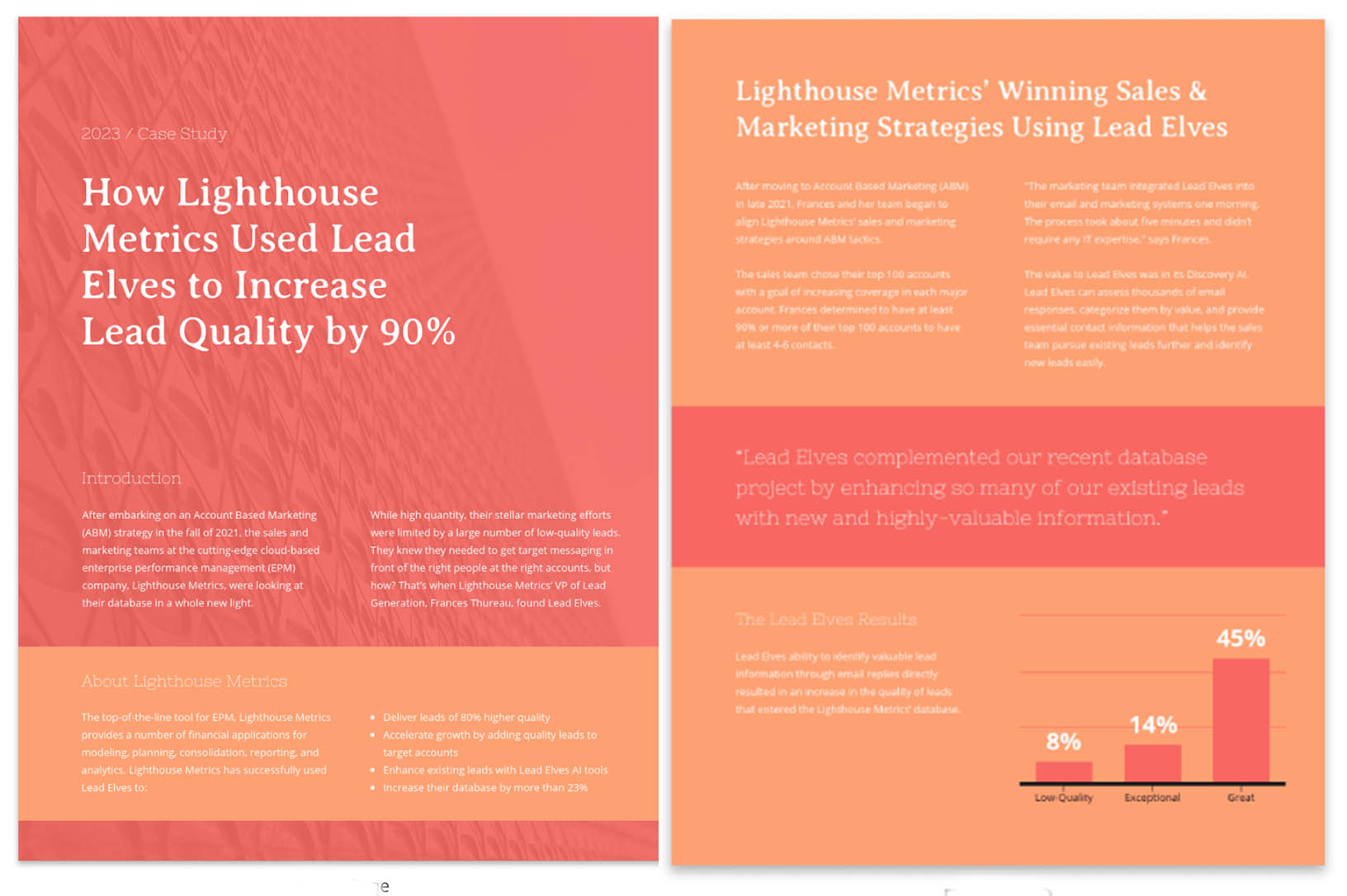
Using charts in your case study can also be useful if you’re creating a project management case study.
You could use a Gantt chart or a project timeline to show how you have managed the project successfully.

Use direct quotes to build trust in your marketing case study
To add an extra layer of authenticity you can include a direct quote from your customer within your case study.
According to research from Nielsen , 92% of people will trust a recommendation from a peer and 70% trust recommendations even if they’re from somebody they don’t know.
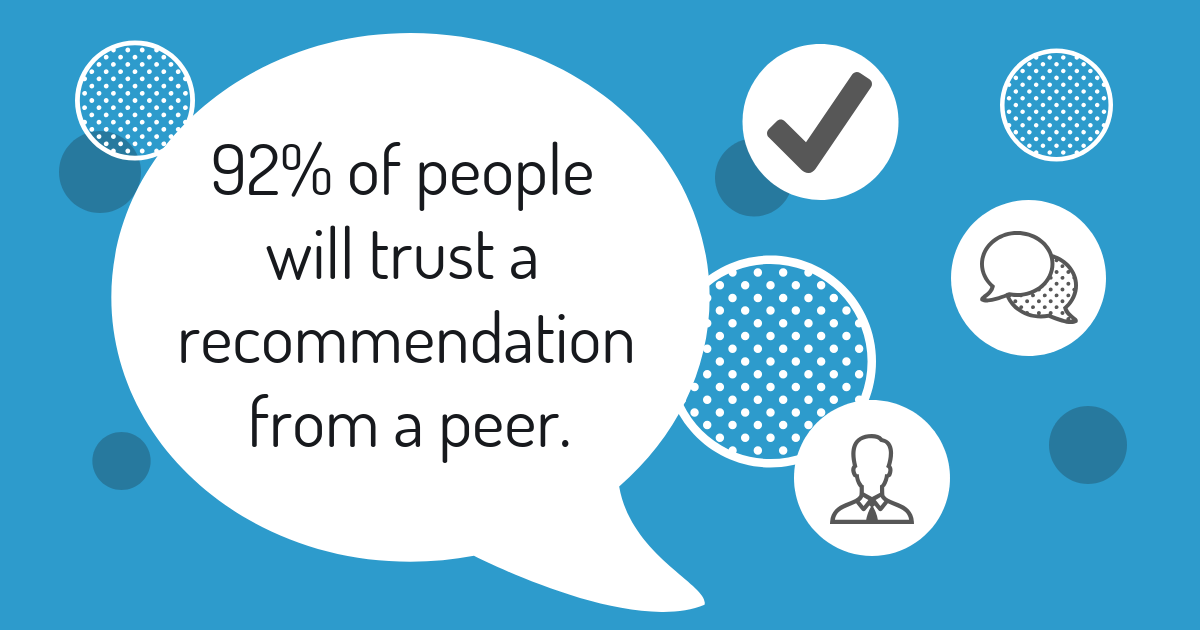
So if you have a customer or client who can’t stop singing your praises, make sure you get a direct quote from them and include it in your case study.
You can either lift part of the conversation or interview, or you can specifically request a quote. Make sure to ask for permission before using the quote.

This design uses a bright contrasting speech bubble to show that it includes a direct quote, and helps the quote stand out from the rest of the text.
This will help draw the customer’s attention directly to the quote, in turn influencing them to use your product or service.
Less is often more, and this is especially true when it comes to creating designs. Whilst you want to create a professional-looking, well-written and design case study – there’s no need to overcomplicate things.
These simple case study examples show that smart clean designs and informative content can be an effective way to showcase your successes.
Use colors and fonts to create a professional-looking case study
Business case studies shouldn’t be boring. In fact, they should be beautifully and professionally designed.
This means the normal rules of design apply. Use fonts, colors, and icons to create an interesting and visually appealing case study.
In this case study example, we can see how multiple fonts have been used to help differentiate between the headers and content, as well as complementary colors and eye-catching icons.
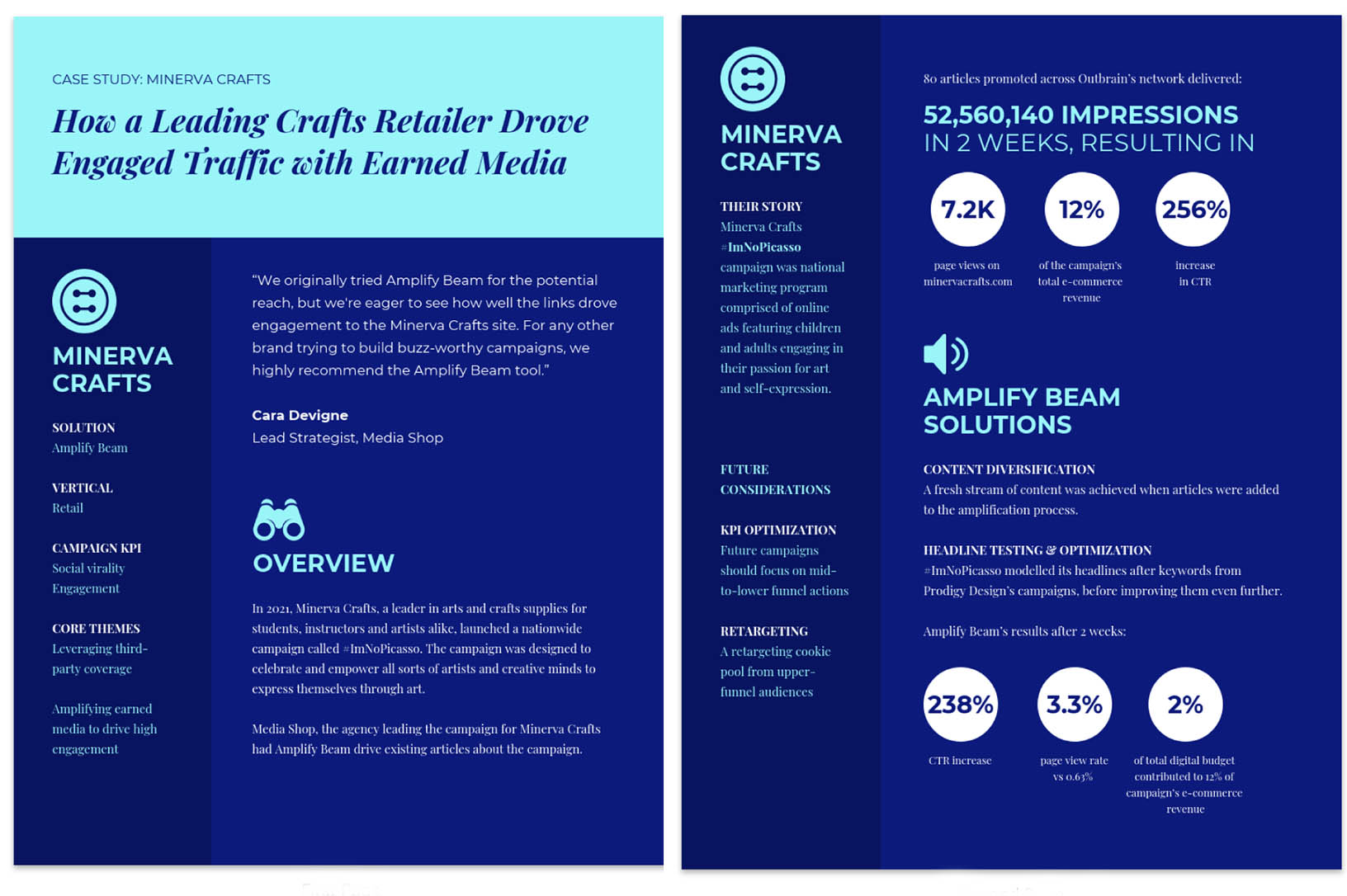
Marketing case study examples
Marketing case studies are incredibly useful for showing your marketing successes. Every successful marketing campaign relies on influencing a consumer’s behavior, and a great case study can be a great way to spotlight your biggest wins.
In the marketing case study examples below, a variety of designs and techniques to create impactful and effective case studies.
Show off impressive results with a bold marketing case study
Case studies are meant to show off your successes, so make sure you feature your positive results prominently. Using bold and bright colors as well as contrasting shapes, large bold fonts, and simple icons is a great way to highlight your wins.
In well-written case study examples like the one below, the big wins are highlighted on the second page with a bright orange color and are highlighted in circles.
Making the important data stand out is especially important when attracting a prospective customer with marketing case studies.

Use a simple but clear layout in your case study
Using a simple layout in your case study can be incredibly effective, like in the example of a case study below.
Keeping a clean white background, and using slim lines to help separate the sections is an easy way to format your case study.
Making the information clear helps draw attention to the important results, and it helps improve the accessibility of the design .
Business case study examples like this would sit nicely within a larger report, with a consistent layout throughout.

Use visuals and icons to create an engaging and branded business case study
Nobody wants to read pages and pages of text — and that’s why Venngage wants to help you communicate your ideas visually.
Using icons, graphics, photos, or patterns helps create a much more engaging design.
With this Blue Cap case study icons, colors, and impactful pattern designs have been used to create an engaging design that catches your eye.

Use a monochromatic color palette to create a professional and clean case study
Let your research shine by using a monochromatic and minimalistic color palette.
By sticking to one color, and leaving lots of blank space you can ensure your design doesn’t distract a potential customer from your case study content.

In this case study on Polygon Media, the design is simple and professional, and the layout allows the prospective customer to follow the flow of information.
The gradient effect on the left-hand column helps break up the white background and adds an interesting visual effect.
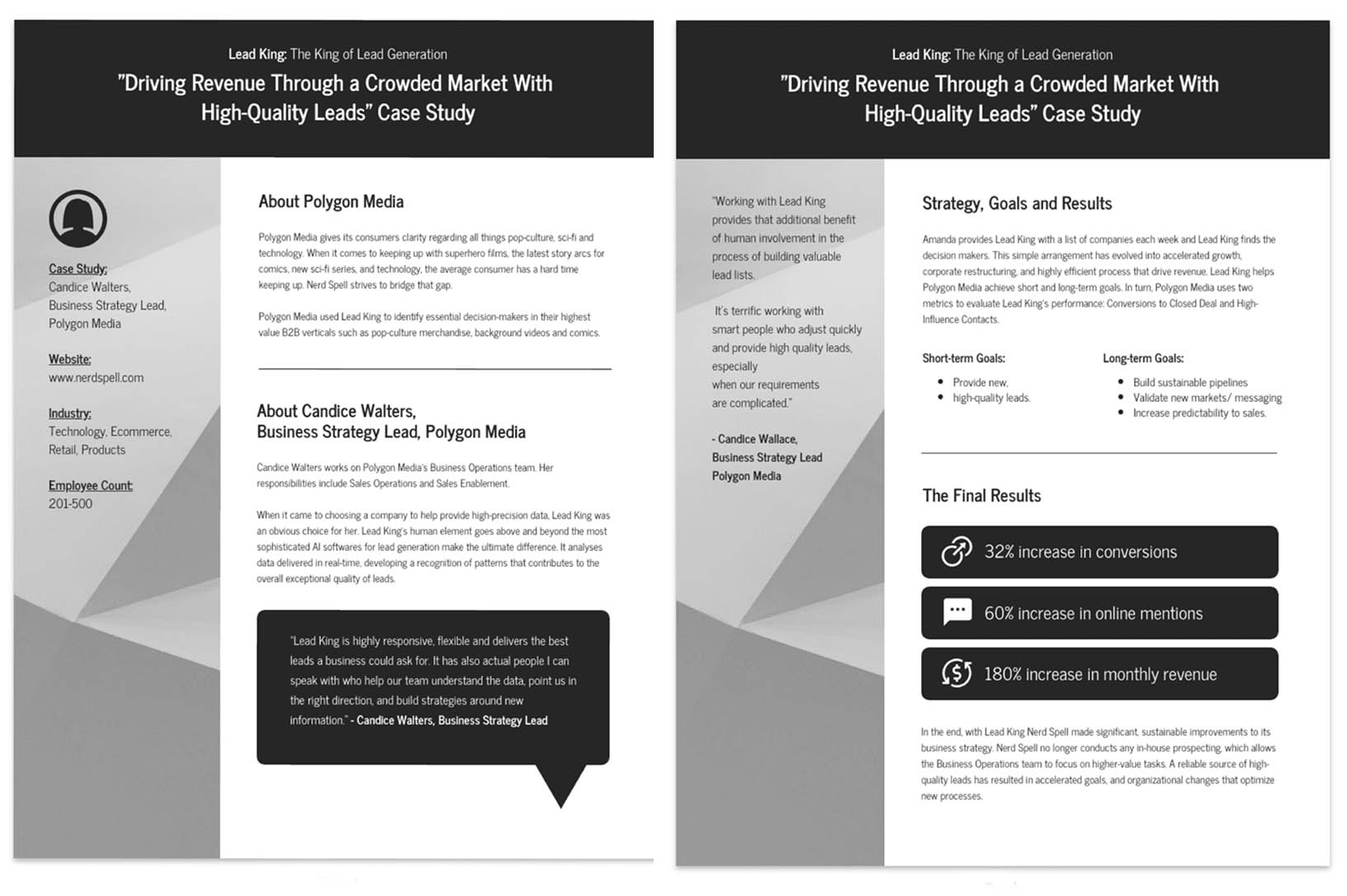
Did you know you can generate an accessible color palette with Venngage? Try our free accessible color palette generator today and create a case study that delivers and looks pleasant to the eye:
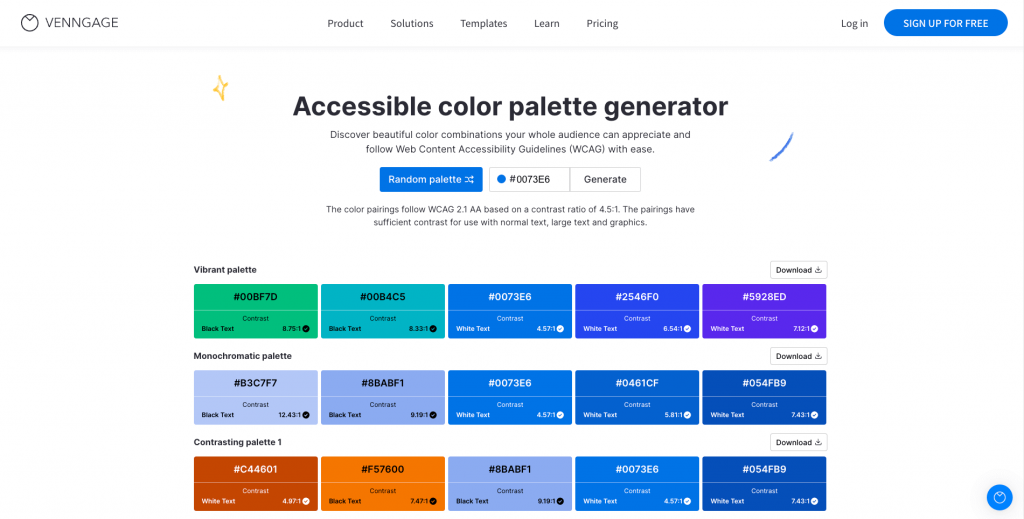
Add long term goals in your case study
When creating a case study it’s a great idea to look at both the short term and the long term goals of the company to gain the best understanding possible of the insights they provide.
Short-term goals will be what the company or person hopes to achieve in the next few months, and long-term goals are what the company hopes to achieve in the next few years.
Check out this modern pattern design example of a case study below:

In this case study example, the short and long-term goals are clearly distinguished by light blue boxes and placed side by side so that they are easy to compare.

Use a strong introductory paragraph to outline the overall strategy and goals before outlining the specific short-term and long-term goals to help with clarity.
This strategy can also be handy when creating a consulting case study.
Use data to make concrete points about your sales and successes
When conducting any sort of research stats, facts, and figures are like gold dust (aka, really valuable).
Being able to quantify your findings is important to help understand the information fully. Saying sales increased 10% is much more effective than saying sales increased.
While sales dashboards generally tend it make it all about the numbers and charts, in sales case study examples, like this one, the key data and findings can be presented with icons. This contributes to the potential customer’s better understanding of the report.
They can clearly comprehend the information and it shows that the case study has been well researched.

Use emotive, persuasive, or action based language in your marketing case study
Create a compelling case study by using emotive, persuasive and action-based language when customizing your case study template.

In this well-written case study example, we can see that phrases such as “Results that Speak Volumes” and “Drive Sales” have been used.
Using persuasive language like you would in a blog post. It helps inspire potential customers to take action now.

Keep your potential customers in mind when creating a customer case study for marketing
82% of marketers use case studies in their marketing because it’s such an effective tool to help quickly gain customers’ trust and to showcase the potential of your product.
Why are case studies such an important tool in content marketing?
By writing a case study you’re telling potential customers that they can trust you because you’re showing them that other people do.
Not only that, but if you have a SaaS product, business case studies are a great way to show how other people are effectively using your product in their company.
In this case study, Network is demonstrating how their product has been used by Vortex Co. with great success; instantly showing other potential customers that their tool works and is worth using.

Related: 10+ Case Study Infographic Templates That Convert
Case studies are particularly effective as a sales technique.
A sales case study is like an extended customer testimonial, not only sharing opinions of your product – but showcasing the results you helped your customer achieve.
Make impactful statistics pop in your sales case study
Writing a case study doesn’t mean using text as the only medium for sharing results.
You should use icons to highlight areas of your research that are particularly interesting or relevant, like in this example of a case study:

Icons are a great way to help summarize information quickly and can act as visual cues to help draw the customer’s attention to certain areas of the page.
In some of the business case study examples above, icons are used to represent the impressive areas of growth and are presented in a way that grabs your attention.
Use high contrast shapes and colors to draw attention to key information in your sales case study
Help the key information stand out within your case study by using high contrast shapes and colors.
Use a complementary or contrasting color, or use a shape such as a rectangle or a circle for maximum impact.

This design has used dark blue rectangles to help separate the information and make it easier to read.
Coupled with icons and strong statistics, this information stands out on the page and is easily digestible and retainable for a potential customer.

Case Study Examples Summary
Once you have created your case study, it’s best practice to update your examples on a regular basis to include up-to-date statistics, data, and information.
You should update your business case study examples often if you are sharing them on your website .
It’s also important that your case study sits within your brand guidelines – find out how Venngage’s My Brand Kit tool can help you create consistently branded case study templates.
Case studies are important marketing tools – but they shouldn’t be the only tool in your toolbox. Content marketing is also a valuable way to earn consumer trust.
Case Study FAQ
Why should you write a case study.
Case studies are an effective marketing technique to engage potential customers and help build trust.
By producing case studies featuring your current clients or customers, you are showcasing how your tool or product can be used. You’re also showing that other people endorse your product.
In addition to being a good way to gather positive testimonials from existing customers , business case studies are good educational resources and can be shared amongst your company or team, and used as a reference for future projects.
How should you write a case study?
To create a great case study, you should think strategically. The first step, before starting your case study research, is to think about what you aim to learn or what you aim to prove.
You might be aiming to learn how a company makes sales or develops a new product. If this is the case, base your questions around this.
You can learn more about writing a case study from our extensive guide.
Related: How to Present a Case Study like a Pro (With Examples)
Some good questions you could ask would be:
- Why do you use our tool or service?
- How often do you use our tool or service?
- What does the process of using our product look like to you?
- If our product didn’t exist, what would you be doing instead?
- What is the number one benefit you’ve found from using our tool?
You might also enjoy:
- 12 Essential Consulting Templates For Marketing, Planning and Branding
- Best Marketing Strategies for Consultants and Freelancers in 2019 [Study + Infographic]
All You Wanted to Know About How to Write a Case Study

What do you study in your college? If you are a psychology, sociology, or anthropology student, we bet you might be familiar with what a case study is. This research method is used to study a certain person, group, or situation. In this guide from our dissertation writing service , you will learn how to write a case study professionally, from researching to citing sources properly. Also, we will explore different types of case studies and show you examples — so that you won’t have any other questions left.
What Is a Case Study?
A case study is a subcategory of research design which investigates problems and offers solutions. Case studies can range from academic research studies to corporate promotional tools trying to sell an idea—their scope is quite vast.
What Is the Difference Between a Research Paper and a Case Study?
While research papers turn the reader’s attention to a certain problem, case studies go even further. Case study guidelines require students to pay attention to details, examining issues closely and in-depth using different research methods. For example, case studies may be used to examine court cases if you study Law, or a patient's health history if you study Medicine. Case studies are also used in Marketing, which are thorough, empirically supported analysis of a good or service's performance. Well-designed case studies can be valuable for prospective customers as they can identify and solve the potential customers pain point.
Case studies involve a lot of storytelling – they usually examine particular cases for a person or a group of people. This method of research is very helpful, as it is very practical and can give a lot of hands-on information. Most commonly, the length of the case study is about 500-900 words, which is much less than the length of an average research paper.
The structure of a case study is very similar to storytelling. It has a protagonist or main character, which in your case is actually a problem you are trying to solve. You can use the system of 3 Acts to make it a compelling story. It should have an introduction, rising action, a climax where transformation occurs, falling action, and a solution.
Here is a rough formula for you to use in your case study:
Problem (Act I): > Solution (Act II) > Result (Act III) > Conclusion.
Types of Case Studies
The purpose of a case study is to provide detailed reports on an event, an institution, a place, future customers, or pretty much anything. There are a few common types of case study, but the type depends on the topic. The following are the most common domains where case studies are needed:

- Historical case studies are great to learn from. Historical events have a multitude of source info offering different perspectives. There are always modern parallels where these perspectives can be applied, compared, and thoroughly analyzed.
- Problem-oriented case studies are usually used for solving problems. These are often assigned as theoretical situations where you need to immerse yourself in the situation to examine it. Imagine you’re working for a startup and you’ve just noticed a significant flaw in your product’s design. Before taking it to the senior manager, you want to do a comprehensive study on the issue and provide solutions. On a greater scale, problem-oriented case studies are a vital part of relevant socio-economic discussions.
- Cumulative case studies collect information and offer comparisons. In business, case studies are often used to tell people about the value of a product.
- Critical case studies explore the causes and effects of a certain case.
- Illustrative case studies describe certain events, investigating outcomes and lessons learned.
Need a compelling case study? EssayPro has got you covered. Our experts are ready to provide you with detailed, insightful case studies that capture the essence of real-world scenarios. Elevate your academic work with our professional assistance.

Case Study Format
The case study format is typically made up of eight parts:
- Executive Summary. Explain what you will examine in the case study. Write an overview of the field you’re researching. Make a thesis statement and sum up the results of your observation in a maximum of 2 sentences.
- Background. Provide background information and the most relevant facts. Isolate the issues.
- Case Evaluation. Isolate the sections of the study you want to focus on. In it, explain why something is working or is not working.
- Proposed Solutions. Offer realistic ways to solve what isn’t working or how to improve its current condition. Explain why these solutions work by offering testable evidence.
- Conclusion. Summarize the main points from the case evaluations and proposed solutions. 6. Recommendations. Talk about the strategy that you should choose. Explain why this choice is the most appropriate.
- Implementation. Explain how to put the specific strategies into action.
- References. Provide all the citations.
How to Write a Case Study
Let's discover how to write a case study.

Setting Up the Research
When writing a case study, remember that research should always come first. Reading many different sources and analyzing other points of view will help you come up with more creative solutions. You can also conduct an actual interview to thoroughly investigate the customer story that you'll need for your case study. Including all of the necessary research, writing a case study may take some time. The research process involves doing the following:
- Define your objective. Explain the reason why you’re presenting your subject. Figure out where you will feature your case study; whether it is written, on video, shown as an infographic, streamed as a podcast, etc.
- Determine who will be the right candidate for your case study. Get permission, quotes, and other features that will make your case study effective. Get in touch with your candidate to see if they approve of being part of your work. Study that candidate’s situation and note down what caused it.
- Identify which various consequences could result from the situation. Follow these guidelines on how to start a case study: surf the net to find some general information you might find useful.
- Make a list of credible sources and examine them. Seek out important facts and highlight problems. Always write down your ideas and make sure to brainstorm.
- Focus on several key issues – why they exist, and how they impact your research subject. Think of several unique solutions. Draw from class discussions, readings, and personal experience. When writing a case study, focus on the best solution and explore it in depth. After having all your research in place, writing a case study will be easy. You may first want to check the rubric and criteria of your assignment for the correct case study structure.
Read Also: 'CREDIBLE SOURCES: WHAT ARE THEY?'
Although your instructor might be looking at slightly different criteria, every case study rubric essentially has the same standards. Your professor will want you to exhibit 8 different outcomes:
- Correctly identify the concepts, theories, and practices in the discipline.
- Identify the relevant theories and principles associated with the particular study.
- Evaluate legal and ethical principles and apply them to your decision-making.
- Recognize the global importance and contribution of your case.
- Construct a coherent summary and explanation of the study.
- Demonstrate analytical and critical-thinking skills.
- Explain the interrelationships between the environment and nature.
- Integrate theory and practice of the discipline within the analysis.
Need Case Study DONE FAST?
Pick a topic, tell us your requirements and get your paper on time.
Case Study Outline
Let's look at the structure of an outline based on the issue of the alcoholic addiction of 30 people.
Introduction
- Statement of the issue: Alcoholism is a disease rather than a weakness of character.
- Presentation of the problem: Alcoholism is affecting more than 14 million people in the USA, which makes it the third most common mental illness there.
- Explanation of the terms: In the past, alcoholism was commonly referred to as alcohol dependence or alcohol addiction. Alcoholism is now the more severe stage of this addiction in the disorder spectrum.
- Hypotheses: Drinking in excess can lead to the use of other drugs.
- Importance of your story: How the information you present can help people with their addictions.
- Background of the story: Include an explanation of why you chose this topic.
- Presentation of analysis and data: Describe the criteria for choosing 30 candidates, the structure of the interview, and the outcomes.
- Strong argument 1: ex. X% of candidates dealing with anxiety and depression...
- Strong argument 2: ex. X amount of people started drinking by their mid-teens.
- Strong argument 3: ex. X% of respondents’ parents had issues with alcohol.
- Concluding statement: I have researched if alcoholism is a disease and found out that…
- Recommendations: Ways and actions for preventing alcohol use.
Writing a Case Study Draft
After you’ve done your case study research and written the outline, it’s time to focus on the draft. In a draft, you have to develop and write your case study by using: the data which you collected throughout the research, interviews, and the analysis processes that were undertaken. Follow these rules for the draft:
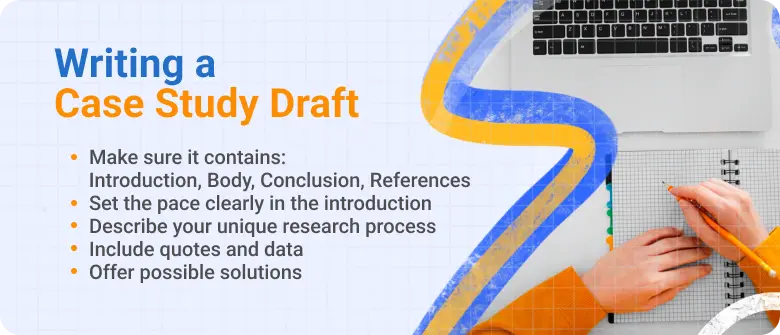
- Your draft should contain at least 4 sections: an introduction; a body where you should include background information, an explanation of why you decided to do this case study, and a presentation of your main findings; a conclusion where you present data; and references.
- In the introduction, you should set the pace very clearly. You can even raise a question or quote someone you interviewed in the research phase. It must provide adequate background information on the topic. The background may include analyses of previous studies on your topic. Include the aim of your case here as well. Think of it as a thesis statement. The aim must describe the purpose of your work—presenting the issues that you want to tackle. Include background information, such as photos or videos you used when doing the research.
- Describe your unique research process, whether it was through interviews, observations, academic journals, etc. The next point includes providing the results of your research. Tell the audience what you found out. Why is this important, and what could be learned from it? Discuss the real implications of the problem and its significance in the world.
- Include quotes and data (such as findings, percentages, and awards). This will add a personal touch and better credibility to the case you present. Explain what results you find during your interviews in regards to the problem and how it developed. Also, write about solutions which have already been proposed by other people who have already written about this case.
- At the end of your case study, you should offer possible solutions, but don’t worry about solving them yourself.
Use Data to Illustrate Key Points in Your Case Study
Even though your case study is a story, it should be based on evidence. Use as much data as possible to illustrate your point. Without the right data, your case study may appear weak and the readers may not be able to relate to your issue as much as they should. Let's see the examples from essay writing service :
With data: Alcoholism is affecting more than 14 million people in the USA, which makes it the third most common mental illness there. Without data: A lot of people suffer from alcoholism in the United States.
Try to include as many credible sources as possible. You may have terms or sources that could be hard for other cultures to understand. If this is the case, you should include them in the appendix or Notes for the Instructor or Professor.
Finalizing the Draft: Checklist
After you finish drafting your case study, polish it up by answering these ‘ask yourself’ questions and think about how to end your case study:
- Check that you follow the correct case study format, also in regards to text formatting.
- Check that your work is consistent with its referencing and citation style.
- Micro-editing — check for grammar and spelling issues.
- Macro-editing — does ‘the big picture’ come across to the reader? Is there enough raw data, such as real-life examples or personal experiences? Have you made your data collection process completely transparent? Does your analysis provide a clear conclusion, allowing for further research and practice?
Problems to avoid:
- Overgeneralization – Do not go into further research that deviates from the main problem.
- Failure to Document Limitations – Just as you have to clearly state the limitations of a general research study, you must describe the specific limitations inherent in the subject of analysis.
- Failure to Extrapolate All Possible Implications – Just as you don't want to over-generalize from your case study findings, you also have to be thorough in the consideration of all possible outcomes or recommendations derived from your findings.
How to Create a Title Page and Cite a Case Study
Let's see how to create an awesome title page.
Your title page depends on the prescribed citation format. The title page should include:
- A title that attracts some attention and describes your study
- The title should have the words “case study” in it
- The title should range between 5-9 words in length
- Your name and contact information
- Your finished paper should be only 500 to 1,500 words in length.With this type of assignment, write effectively and avoid fluff
Here is a template for the APA and MLA format title page:
There are some cases when you need to cite someone else's study in your own one – therefore, you need to master how to cite a case study. A case study is like a research paper when it comes to citations. You can cite it like you cite a book, depending on what style you need.
Citation Example in MLA Hill, Linda, Tarun Khanna, and Emily A. Stecker. HCL Technologies. Boston: Harvard Business Publishing, 2008. Print.
Citation Example in APA Hill, L., Khanna, T., & Stecker, E. A. (2008). HCL Technologies. Boston: Harvard Business Publishing.
Citation Example in Chicago Hill, Linda, Tarun Khanna, and Emily A. Stecker. HCL Technologies.
Case Study Examples
To give you an idea of a professional case study example, we gathered and linked some below.
Eastman Kodak Case Study
Case Study Example: Audi Trains Mexican Autoworkers in Germany
To conclude, a case study is one of the best methods of getting an overview of what happened to a person, a group, or a situation in practice. It allows you to have an in-depth glance at the real-life problems that businesses, healthcare industry, criminal justice, etc. may face. This insight helps us look at such situations in a different light. This is because we see scenarios that we otherwise would not, without necessarily being there. If you need custom essays , try our research paper writing services .
Get Help Form Qualified Writers
Crafting a case study is not easy. You might want to write one of high quality, but you don’t have the time or expertise. If you’re having trouble with your case study, help with essay request - we'll help. EssayPro writers have read and written countless case studies and are experts in endless disciplines. Request essay writing, editing, or proofreading assistance from our custom case study writing service , and all of your worries will be gone.
Don't Know Where to Start?
Crafting a case study is not easy. You might want to write one of high quality, but you don’t have the time or expertise. Request ' write my case study ' assistance from our service.
What Is A Case Study?
How to cite a case study in apa, how to write a case study, related articles.
.webp)
How to write a case study — examples, templates, and tools

It’s a marketer’s job to communicate the effectiveness of a product or service to potential and current customers to convince them to buy and keep business moving. One of the best methods for doing this is to share success stories that are relatable to prospects and customers based on their pain points, experiences, and overall needs.
That’s where case studies come in. Case studies are an essential part of a content marketing plan. These in-depth stories of customer experiences are some of the most effective at demonstrating the value of a product or service. Yet many marketers don’t use them, whether because of their regimented formats or the process of customer involvement and approval.
A case study is a powerful tool for showcasing your hard work and the success your customer achieved. But writing a great case study can be difficult if you’ve never done it before or if it’s been a while. This guide will show you how to write an effective case study and provide real-world examples and templates that will keep readers engaged and support your business.
In this article, you’ll learn:
What is a case study?
How to write a case study, case study templates, case study examples, case study tools.
A case study is the detailed story of a customer’s experience with a product or service that demonstrates their success and often includes measurable outcomes. Case studies are used in a range of fields and for various reasons, from business to academic research. They’re especially impactful in marketing as brands work to convince and convert consumers with relatable, real-world stories of actual customer experiences.
The best case studies tell the story of a customer’s success, including the steps they took, the results they achieved, and the support they received from a brand along the way. To write a great case study, you need to:
- Celebrate the customer and make them — not a product or service — the star of the story.
- Craft the story with specific audiences or target segments in mind so that the story of one customer will be viewed as relatable and actionable for another customer.
- Write copy that is easy to read and engaging so that readers will gain the insights and messages intended.
- Follow a standardized format that includes all of the essentials a potential customer would find interesting and useful.
- Support all of the claims for success made in the story with data in the forms of hard numbers and customer statements.
Case studies are a type of review but more in depth, aiming to show — rather than just tell — the positive experiences that customers have with a brand. Notably, 89% of consumers read reviews before deciding to buy, and 79% view case study content as part of their purchasing process. When it comes to B2B sales, 52% of buyers rank case studies as an important part of their evaluation process.
Telling a brand story through the experience of a tried-and-true customer matters. The story is relatable to potential new customers as they imagine themselves in the shoes of the company or individual featured in the case study. Showcasing previous customers can help new ones see themselves engaging with your brand in the ways that are most meaningful to them.
Besides sharing the perspective of another customer, case studies stand out from other content marketing forms because they are based on evidence. Whether pulling from client testimonials or data-driven results, case studies tend to have more impact on new business because the story contains information that is both objective (data) and subjective (customer experience) — and the brand doesn’t sound too self-promotional.

Case studies are unique in that there’s a fairly standardized format for telling a customer’s story. But that doesn’t mean there isn’t room for creativity. It’s all about making sure that teams are clear on the goals for the case study — along with strategies for supporting content and channels — and understanding how the story fits within the framework of the company’s overall marketing goals.
Here are the basic steps to writing a good case study.
1. Identify your goal
Start by defining exactly who your case study will be designed to help. Case studies are about specific instances where a company works with a customer to achieve a goal. Identify which customers are likely to have these goals, as well as other needs the story should cover to appeal to them.
The answer is often found in one of the buyer personas that have been constructed as part of your larger marketing strategy. This can include anything from new leads generated by the marketing team to long-term customers that are being pressed for cross-sell opportunities. In all of these cases, demonstrating value through a relatable customer success story can be part of the solution to conversion.
2. Choose your client or subject
Who you highlight matters. Case studies tie brands together that might otherwise not cross paths. A writer will want to ensure that the highlighted customer aligns with their own company’s brand identity and offerings. Look for a customer with positive name recognition who has had great success with a product or service and is willing to be an advocate.
The client should also match up with the identified target audience. Whichever company or individual is selected should be a reflection of other potential customers who can see themselves in similar circumstances, having the same problems and possible solutions.
Some of the most compelling case studies feature customers who:
- Switch from one product or service to another while naming competitors that missed the mark.
- Experience measurable results that are relatable to others in a specific industry.
- Represent well-known brands and recognizable names that are likely to compel action.
- Advocate for a product or service as a champion and are well-versed in its advantages.
Whoever or whatever customer is selected, marketers must ensure they have the permission of the company involved before getting started. Some brands have strict review and approval procedures for any official marketing or promotional materials that include their name. Acquiring those approvals in advance will prevent any miscommunication or wasted effort if there is an issue with their legal or compliance teams.
3. Conduct research and compile data
Substantiating the claims made in a case study — either by the marketing team or customers themselves — adds validity to the story. To do this, include data and feedback from the client that defines what success looks like. This can be anything from demonstrating return on investment (ROI) to a specific metric the customer was striving to improve. Case studies should prove how an outcome was achieved and show tangible results that indicate to the customer that your solution is the right one.
This step could also include customer interviews. Make sure that the people being interviewed are key stakeholders in the purchase decision or deployment and use of the product or service that is being highlighted. Content writers should work off a set list of questions prepared in advance. It can be helpful to share these with the interviewees beforehand so they have time to consider and craft their responses. One of the best interview tactics to keep in mind is to ask questions where yes and no are not natural answers. This way, your subject will provide more open-ended responses that produce more meaningful content.
4. Choose the right format
There are a number of different ways to format a case study. Depending on what you hope to achieve, one style will be better than another. However, there are some common elements to include, such as:
- An engaging headline
- A subject and customer introduction
- The unique challenge or challenges the customer faced
- The solution the customer used to solve the problem
- The results achieved
- Data and statistics to back up claims of success
- A strong call to action (CTA) to engage with the vendor
It’s also important to note that while case studies are traditionally written as stories, they don’t have to be in a written format. Some companies choose to get more creative with their case studies and produce multimedia content, depending on their audience and objectives. Case study formats can include traditional print stories, interactive web or social content, data-heavy infographics, professionally shot videos, podcasts, and more.
5. Write your case study
We’ll go into more detail later about how exactly to write a case study, including templates and examples. Generally speaking, though, there are a few things to keep in mind when writing your case study.
- Be clear and concise. Readers want to get to the point of the story quickly and easily, and they’ll be looking to see themselves reflected in the story right from the start.
- Provide a big picture. Always make sure to explain who the client is, their goals, and how they achieved success in a short introduction to engage the reader.
- Construct a clear narrative. Stick to the story from the perspective of the customer and what they needed to solve instead of just listing product features or benefits.
- Leverage graphics. Incorporating infographics, charts, and sidebars can be a more engaging and eye-catching way to share key statistics and data in readable ways.
- Offer the right amount of detail. Most case studies are one or two pages with clear sections that a reader can skim to find the information most important to them.
- Include data to support claims. Show real results — both facts and figures and customer quotes — to demonstrate credibility and prove the solution works.
6. Promote your story
Marketers have a number of options for distribution of a freshly minted case study. Many brands choose to publish case studies on their website and post them on social media. This can help support SEO and organic content strategies while also boosting company credibility and trust as visitors see that other businesses have used the product or service.
Marketers are always looking for quality content they can use for lead generation. Consider offering a case study as gated content behind a form on a landing page or as an offer in an email message. One great way to do this is to summarize the content and tease the full story available for download after the user takes an action.
Sales teams can also leverage case studies, so be sure they are aware that the assets exist once they’re published. Especially when it comes to larger B2B sales, companies often ask for examples of similar customer challenges that have been solved.
Now that you’ve learned a bit about case studies and what they should include, you may be wondering how to start creating great customer story content. Here are a couple of templates you can use to structure your case study.
Template 1 — Challenge-solution-result format
- Start with an engaging title. This should be fewer than 70 characters long for SEO best practices. One of the best ways to approach the title is to include the customer’s name and a hint at the challenge they overcame in the end.
- Create an introduction. Lead with an explanation as to who the customer is, the need they had, and the opportunity they found with a specific product or solution. Writers can also suggest the success the customer experienced with the solution they chose.
- Present the challenge. This should be several paragraphs long and explain the problem the customer faced and the issues they were trying to solve. Details should tie into the company’s products and services naturally. This section needs to be the most relatable to the reader so they can picture themselves in a similar situation.
- Share the solution. Explain which product or service offered was the ideal fit for the customer and why. Feel free to delve into their experience setting up, purchasing, and onboarding the solution.
- Explain the results. Demonstrate the impact of the solution they chose by backing up their positive experience with data. Fill in with customer quotes and tangible, measurable results that show the effect of their choice.
- Ask for action. Include a CTA at the end of the case study that invites readers to reach out for more information, try a demo, or learn more — to nurture them further in the marketing pipeline. What you ask of the reader should tie directly into the goals that were established for the case study in the first place.
Template 2 — Data-driven format
- Start with an engaging title. Be sure to include a statistic or data point in the first 70 characters. Again, it’s best to include the customer’s name as part of the title.
- Create an overview. Share the customer’s background and a short version of the challenge they faced. Present the reason a particular product or service was chosen, and feel free to include quotes from the customer about their selection process.
- Present data point 1. Isolate the first metric that the customer used to define success and explain how the product or solution helped to achieve this goal. Provide data points and quotes to substantiate the claim that success was achieved.
- Present data point 2. Isolate the second metric that the customer used to define success and explain what the product or solution did to achieve this goal. Provide data points and quotes to substantiate the claim that success was achieved.
- Present data point 3. Isolate the final metric that the customer used to define success and explain what the product or solution did to achieve this goal. Provide data points and quotes to substantiate the claim that success was achieved.
- Summarize the results. Reiterate the fact that the customer was able to achieve success thanks to a specific product or service. Include quotes and statements that reflect customer satisfaction and suggest they plan to continue using the solution.
- Ask for action. Include a CTA at the end of the case study that asks readers to reach out for more information, try a demo, or learn more — to further nurture them in the marketing pipeline. Again, remember that this is where marketers can look to convert their content into action with the customer.
While templates are helpful, seeing a case study in action can also be a great way to learn. Here are some examples of how Adobe customers have experienced success.
Juniper Networks
One example is the Adobe and Juniper Networks case study , which puts the reader in the customer’s shoes. The beginning of the story quickly orients the reader so that they know exactly who the article is about and what they were trying to achieve. Solutions are outlined in a way that shows Adobe Experience Manager is the best choice and a natural fit for the customer. Along the way, quotes from the client are incorporated to help add validity to the statements. The results in the case study are conveyed with clear evidence of scale and volume using tangible data.

The story of Lenovo’s journey with Adobe is one that spans years of planning, implementation, and rollout. The Lenovo case study does a great job of consolidating all of this into a relatable journey that other enterprise organizations can see themselves taking, despite the project size. This case study also features descriptive headers and compelling visual elements that engage the reader and strengthen the content.
Tata Consulting
When it comes to using data to show customer results, this case study does an excellent job of conveying details and numbers in an easy-to-digest manner. Bullet points at the start break up the content while also helping the reader understand exactly what the case study will be about. Tata Consulting used Adobe to deliver elevated, engaging content experiences for a large telecommunications client of its own — an objective that’s relatable for a lot of companies.
Case studies are a vital tool for any marketing team as they enable you to demonstrate the value of your company’s products and services to others. They help marketers do their job and add credibility to a brand trying to promote its solutions by using the experiences and stories of real customers.
When you’re ready to get started with a case study:
- Think about a few goals you’d like to accomplish with your content.
- Make a list of successful clients that would be strong candidates for a case study.
- Reach out to the client to get their approval and conduct an interview.
- Gather the data to present an engaging and effective customer story.
Adobe can help
There are several Adobe products that can help you craft compelling case studies. Adobe Experience Platform helps you collect data and deliver great customer experiences across every channel. Once you’ve created your case studies, Experience Platform will help you deliver the right information to the right customer at the right time for maximum impact.
To learn more, watch the Adobe Experience Platform story .
Keep in mind that the best case studies are backed by data. That’s where Adobe Real-Time Customer Data Platform and Adobe Analytics come into play. With Real-Time CDP, you can gather the data you need to build a great case study and target specific customers to deliver the content to the right audience at the perfect moment.
Watch the Real-Time CDP overview video to learn more.
Finally, Adobe Analytics turns real-time data into real-time insights. It helps your business collect and synthesize data from multiple platforms to make more informed decisions and create the best case study possible.
Request a demo to learn more about Adobe Analytics.
https://business.adobe.com/blog/perspectives/b2b-ecommerce-10-case-studies-inspire-you
https://business.adobe.com/blog/basics/business-case
https://business.adobe.com/blog/basics/what-is-real-time-analytics

Business growth
Marketing tips
16 case study examples (+ 3 templates to make your own)

I like to think of case studies as a business's version of a resume. It highlights what the business can do, lends credibility to its offer, and contains only the positive bullet points that paint it in the best light possible.
Imagine if the guy running your favorite taco truck followed you home so that he could "really dig into how that burrito changed your life." I see the value in the practice. People naturally prefer a tried-and-true burrito just as they prefer tried-and-true products or services.
To help you showcase your success and flesh out your burrito questionnaire, I've put together some case study examples and key takeaways.
What is a case study?
A case study is an in-depth analysis of how your business, product, or service has helped past clients. It can be a document, a webpage, or a slide deck that showcases measurable, real-life results.
For example, if you're a SaaS company, you can analyze your customers' results after a few months of using your product to measure its effectiveness. You can then turn this analysis into a case study that further proves to potential customers what your product can do and how it can help them overcome their challenges.
It changes the narrative from "I promise that we can do X and Y for you" to "Here's what we've done for businesses like yours, and we can do it for you, too."
16 case study examples
While most case studies follow the same structure, quite a few try to break the mold and create something unique. Some businesses lean heavily on design and presentation, while others pursue a detailed, stat-oriented approach. Some businesses try to mix both.
There's no set formula to follow, but I've found that the best case studies utilize impactful design to engage readers and leverage statistics and case details to drive the point home. A case study typically highlights the companies, the challenges, the solution, and the results. The examples below will help inspire you to do it, too.
1. .css-1l9i3yq-Link[class][class][class][class][class]{all:unset;box-sizing:border-box;-webkit-text-fill-color:currentColor;cursor:pointer;}.css-1l9i3yq-Link[class][class][class][class][class]{all:unset;box-sizing:border-box;-webkit-text-decoration:underline;text-decoration:underline;cursor:pointer;-webkit-transition:all 300ms ease-in-out;transition:all 300ms ease-in-out;outline-offset:1px;-webkit-text-fill-color:currentColor;outline:1px solid transparent;}.css-1l9i3yq-Link[class][class][class][class][class][data-color='ocean']{color:#3d4592;}.css-1l9i3yq-Link[class][class][class][class][class][data-color='ocean']:hover{color:#2b2358;}.css-1l9i3yq-Link[class][class][class][class][class][data-color='ocean']:focus{color:#3d4592;outline-color:#3d4592;}.css-1l9i3yq-Link[class][class][class][class][class][data-color='white']{color:#fffdf9;}.css-1l9i3yq-Link[class][class][class][class][class][data-color='white']:hover{color:#a8a5a0;}.css-1l9i3yq-Link[class][class][class][class][class][data-color='white']:focus{color:#fffdf9;outline-color:#fffdf9;}.css-1l9i3yq-Link[class][class][class][class][class][data-color='primary']{color:#3d4592;}.css-1l9i3yq-Link[class][class][class][class][class][data-color='primary']:hover{color:#2b2358;}.css-1l9i3yq-Link[class][class][class][class][class][data-color='primary']:focus{color:#3d4592;outline-color:#3d4592;}.css-1l9i3yq-Link[class][class][class][class][class][data-color='secondary']{color:#fffdf9;}.css-1l9i3yq-Link[class][class][class][class][class][data-color='secondary']:hover{color:#a8a5a0;}.css-1l9i3yq-Link[class][class][class][class][class][data-color='secondary']:focus{color:#fffdf9;outline-color:#fffdf9;}.css-1l9i3yq-Link[class][class][class][class][class][data-weight='inherit']{font-weight:inherit;}.css-1l9i3yq-Link[class][class][class][class][class][data-weight='normal']{font-weight:400;}.css-1l9i3yq-Link[class][class][class][class][class][data-weight='bold']{font-weight:700;} Volcanica Coffee and AdRoll
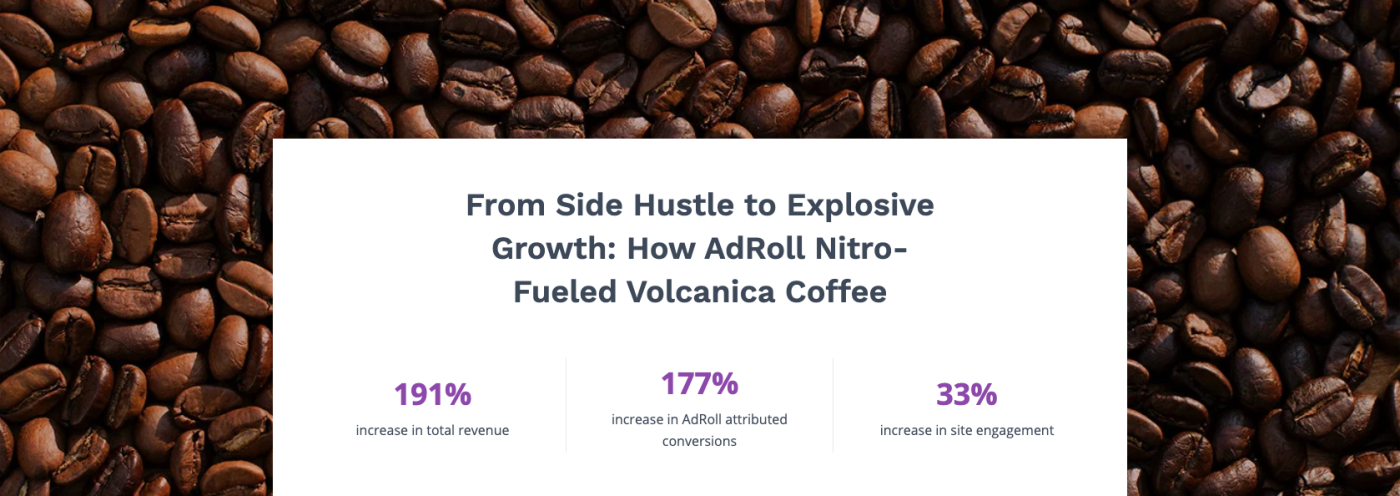
People love a good farm-to-table coffee story, and boy am I one of them. But I've shared this case study with you for more reasons than my love of coffee. I enjoyed this study because it was written as though it was a letter.
In this case study, the founder of Volcanica Coffee talks about the journey from founding the company to personally struggling with learning and applying digital marketing to finding and enlisting AdRoll's services.
It felt more authentic, less about AdRoll showcasing their worth and more like a testimonial from a grateful and appreciative client. After the story, the case study wraps up with successes, milestones, and achievements. Note that quite a few percentages are prominently displayed at the top, providing supporting evidence that backs up an inspiring story.
Takeaway: Highlight your goals and measurable results to draw the reader in and provide concise, easily digestible information.
2. Taylor Guitars and Airtable

This Airtable case study on Taylor Guitars comes as close as one can to an optimal structure. It features a video that represents the artistic nature of the client, highlighting key achievements and dissecting each element of Airtable's influence.
It also supplements each section with a testimonial or quote from the client, using their insights as a catalyst for the case study's narrative. For example, the case study quotes the social media manager and project manager's insights regarding team-wide communication and access before explaining in greater detail.
Takeaway: Highlight pain points your business solves for its client, and explore that influence in greater detail.
3. EndeavourX and Figma

My favorite part of Figma's case study is highlighting why EndeavourX chose its solution. You'll notice an entire section on what Figma does for teams and then specifically for EndeavourX.
It also places a heavy emphasis on numbers and stats. The study, as brief as it is, still manages to pack in a lot of compelling statistics about what's possible with Figma.
Takeaway: Showcase the "how" and "why" of your product's differentiators and how they benefit your customers.
4. ActiveCampaign and Zapier
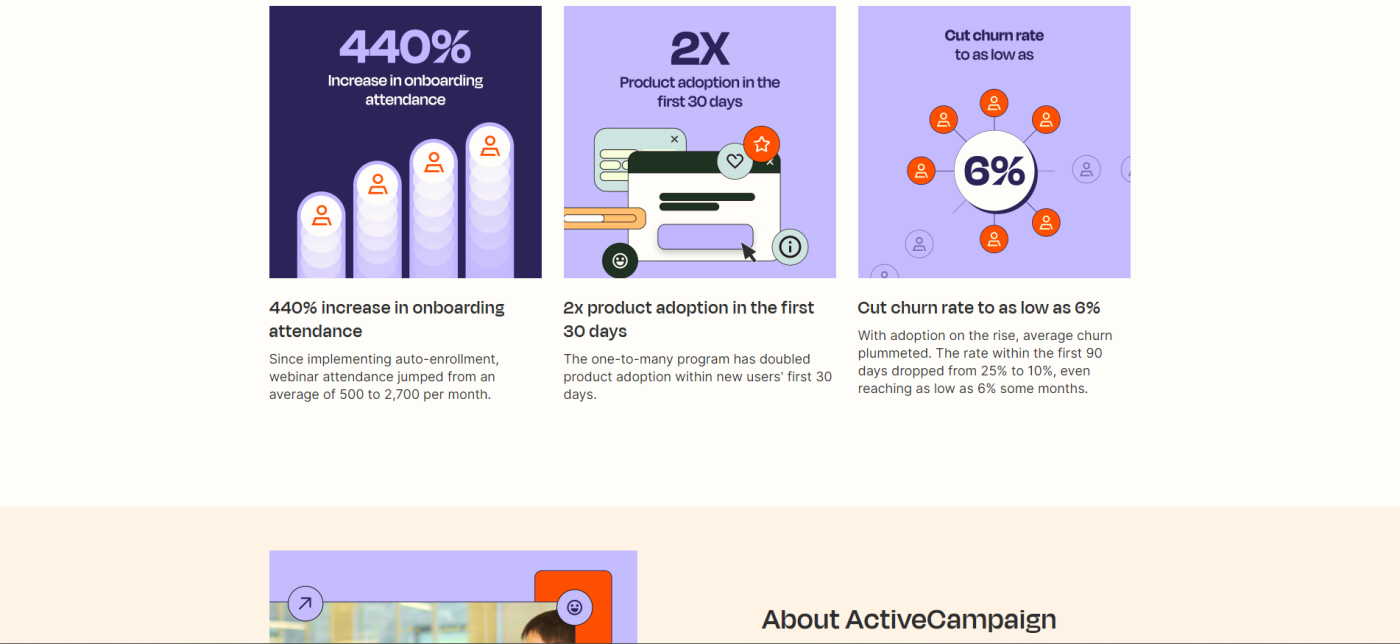
Zapier's case study leans heavily on design, using graphics to present statistics and goals in a manner that not only remains consistent with the branding but also actively pushes it forward, drawing users' eyes to the information most important to them.
The graphics, emphasis on branding elements, and cause/effect style tell the story without requiring long, drawn-out copy that risks boring readers. Instead, the cause and effect are concisely portrayed alongside the client company's information for a brief and easily scannable case study.
Takeaway: Lean on design to call attention to the most important elements of your case study, and make sure it stays consistent with your branding.
5. Ironclad and OpenAI
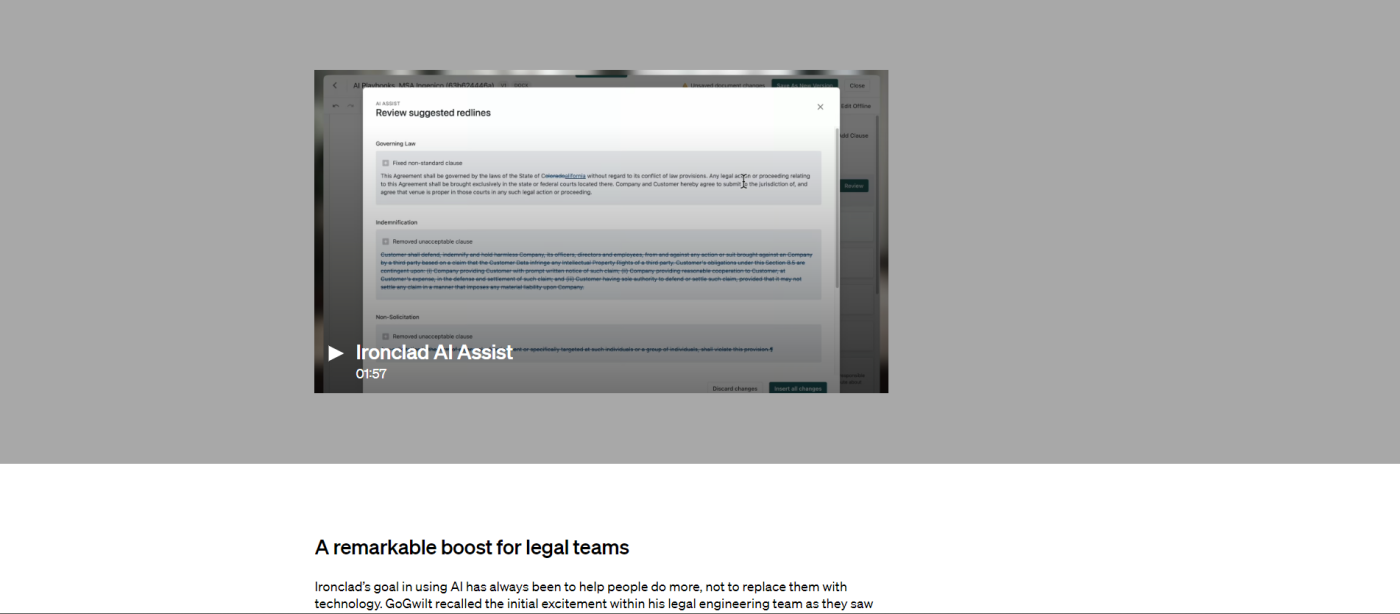
In true OpenAI fashion, this case study is a block of text. There's a distinct lack of imagery, but the study features a narrated video walking readers through the product.
The lack of imagery and color may not be the most inviting, but utilizing video format is commendable. It helps thoroughly communicate how OpenAI supported Ironclad in a way that allows the user to sit back, relax, listen, and be impressed.
Takeaway: Get creative with the media you implement in your case study. Videos can be a very powerful addition when a case study requires more detailed storytelling.
6. Shopify and GitHub

GitHub's case study on Shopify is a light read. It addresses client pain points and discusses the different aspects its product considers and improves for clients. It touches on workflow issues, internal systems, automation, and security. It does a great job of representing what one company can do with GitHub.
To drive the point home, the case study features colorful quote callouts from the Shopify team, sharing their insights and perspectives on the partnership, the key issues, and how they were addressed.
Takeaway: Leverage quotes to boost the authoritativeness and trustworthiness of your case study.
7 . Audible and Contentful
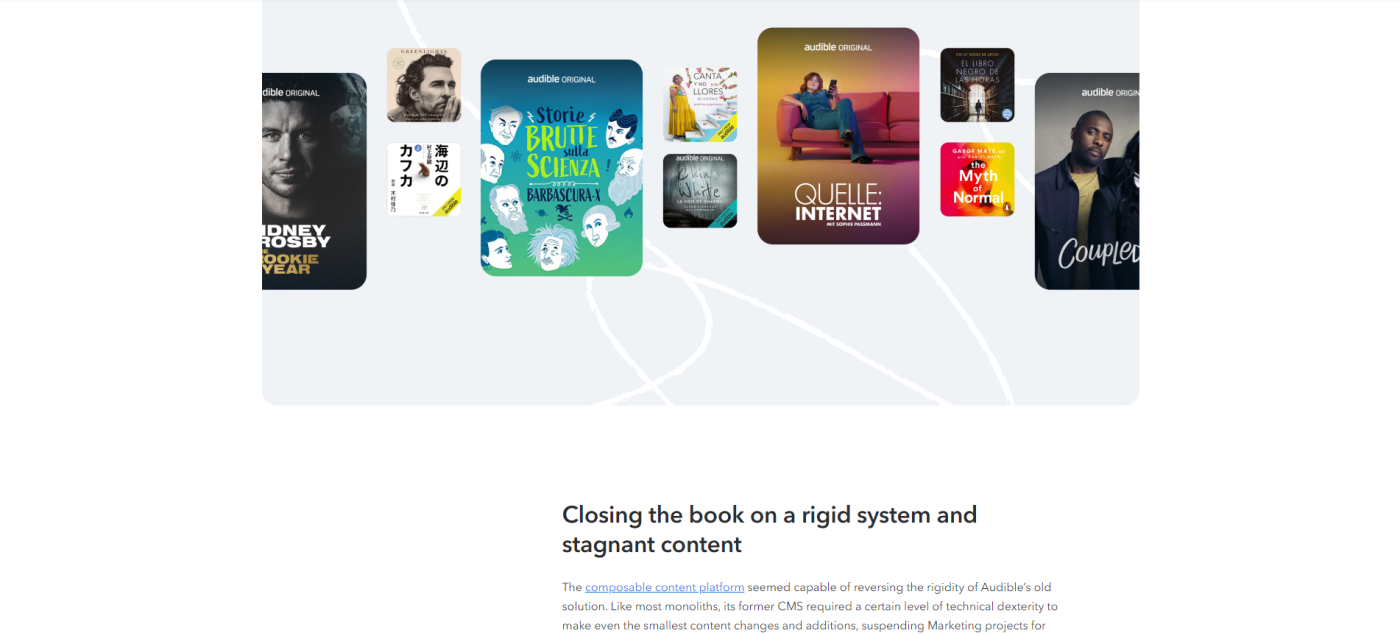
Contentful's case study on Audible features almost every element a case study should. It includes not one but two videos and clearly outlines the challenge, solution, and outcome before diving deeper into what Contentful did for Audible. The language is simple, and the writing is heavy with quotes and personal insights.
This case study is a uniquely original experience. The fact that the companies in question are perhaps two of the most creative brands out there may be the reason. I expected nothing short of a detailed analysis, a compelling story, and video content.
Takeaway: Inject some brand voice into the case study, and create assets that tell the story for you.
8 . Zoom and Asana
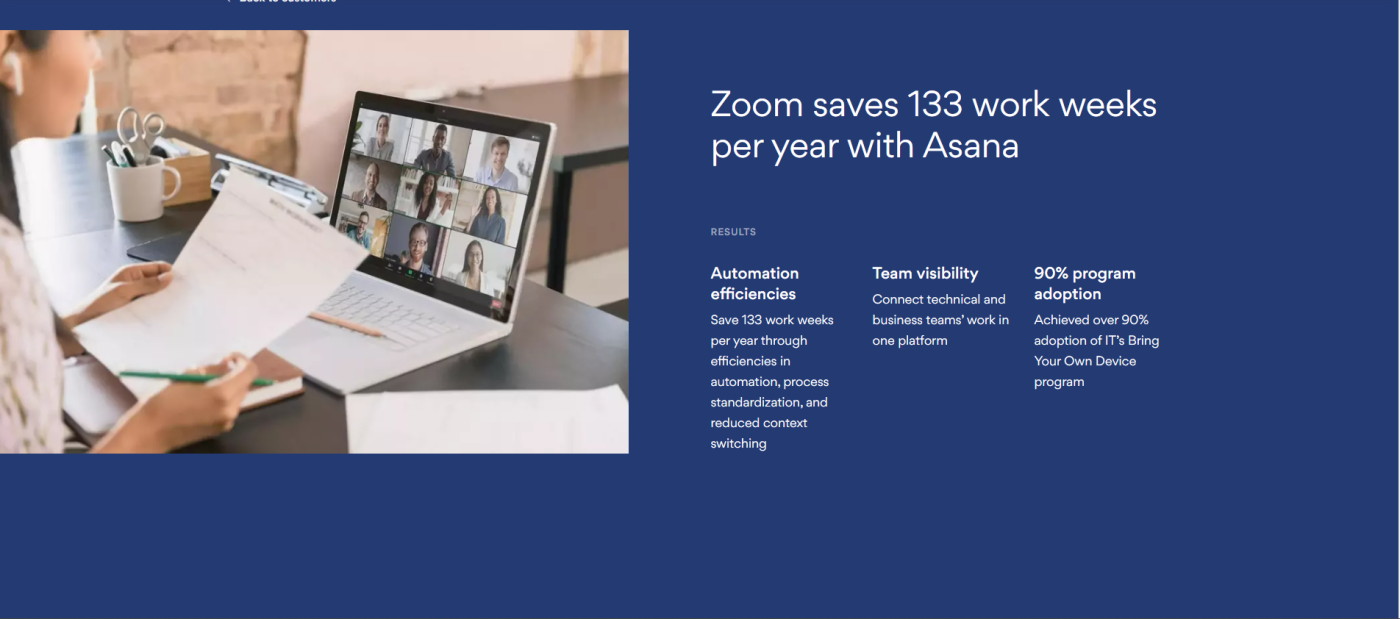
Asana's case study on Zoom is longer than the average piece and features detailed data on Zoom's growth since 2020. Instead of relying on imagery and graphics, it features several quotes and testimonials.
It's designed to be direct, informative, and promotional. At some point, the case study reads more like a feature list. There were a few sections that felt a tad too promotional for my liking, but to each their own burrito.
Takeaway: Maintain a balance between promotional and informative. You want to showcase the high-level goals your product helped achieve without losing the reader.
9 . Hickies and Mailchimp
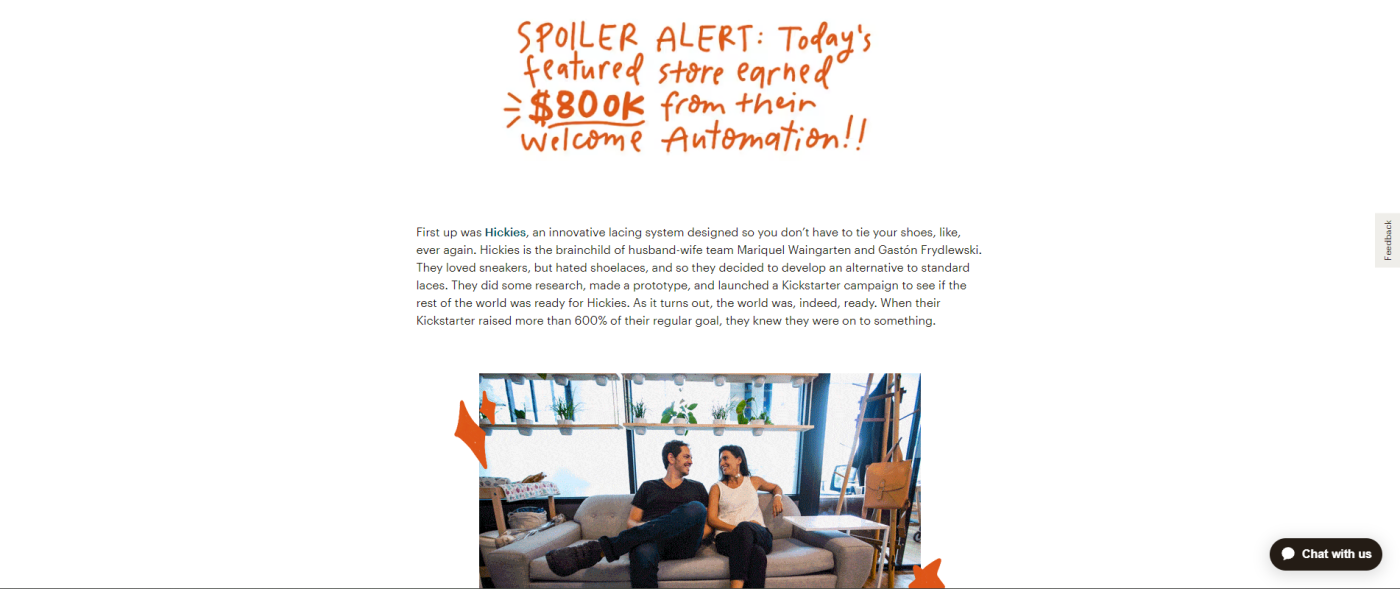
I've always been a fan of Mailchimp's comic-like branding, and this case study does an excellent job of sticking to their tradition of making information easy to understand, casual, and inviting.
It features a short video that briefly covers Hickies as a company and Mailchimp's efforts to serve its needs for customer relationships and education processes. Overall, this case study is a concise overview of the partnership that manages to convey success data and tell a story at the same time. What sets it apart is that it does so in a uniquely colorful and brand-consistent manner.
Takeaway: Be concise to provide as much value in as little text as possible.
10. NVIDIA and Workday
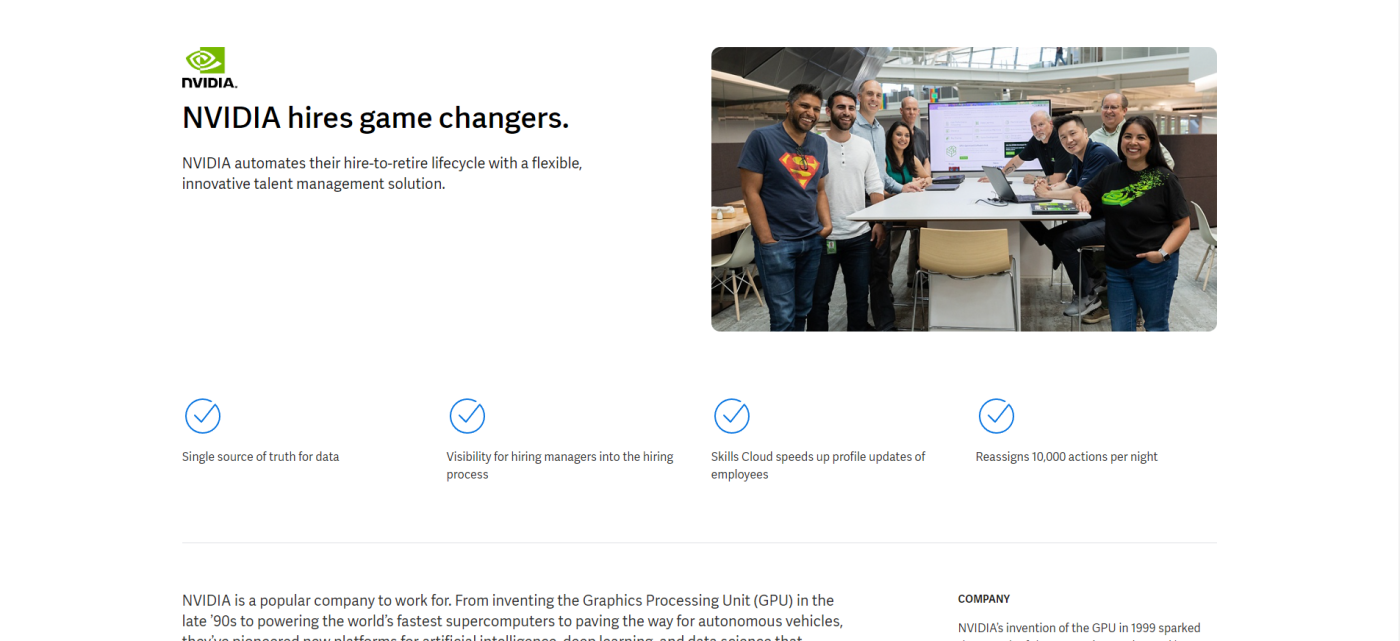
The gaming industry is notoriously difficult to recruit for, as it requires a very specific set of skills and experience. This case study focuses on how Workday was able to help fill that recruitment gap for NVIDIA, one of the biggest names in the gaming world.
Though it doesn't feature videos or graphics, this case study stood out to me in how it structures information like "key products used" to give readers insight into which tools helped achieve these results.
Takeaway: If your company offers multiple products or services, outline exactly which ones were involved in your case study, so readers can assess each tool.
11. KFC and Contentful
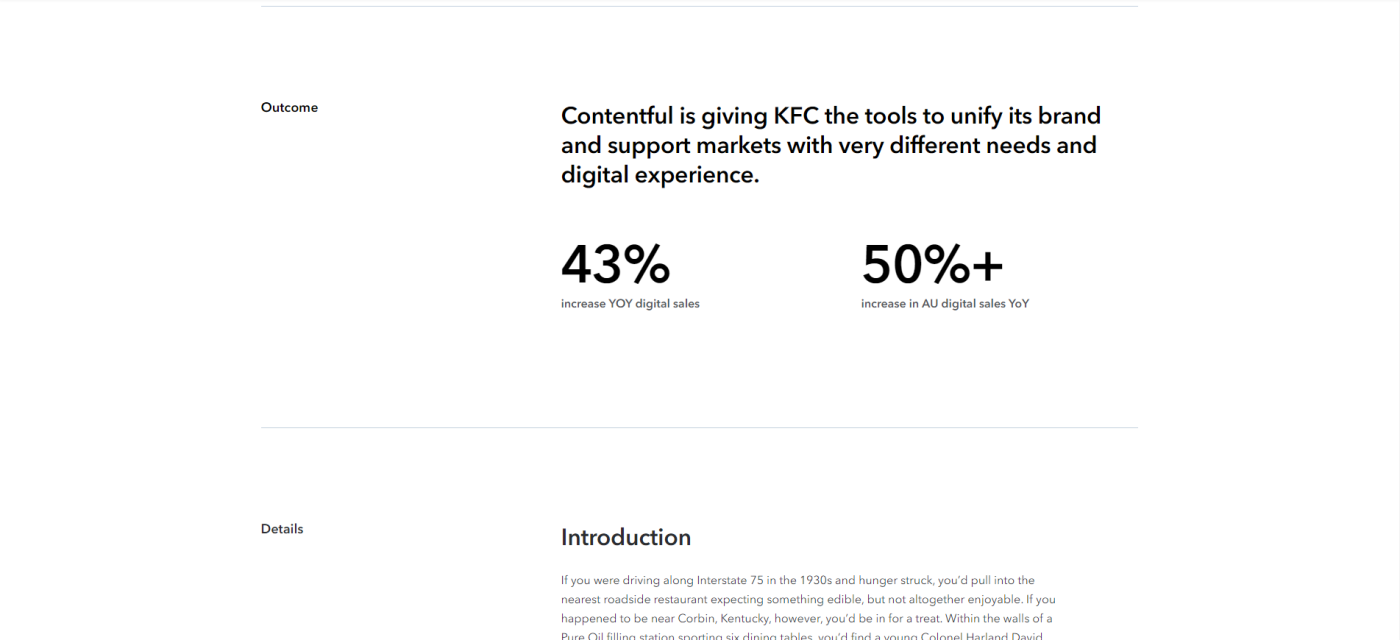
I'm personally not a big KFC fan, but that's only because I refuse to eat out of a bucket. My aversion to the bucket format aside, Contentful follows its consistent case study format in this one, outlining challenges, solutions, and outcomes before diving into the nitty-gritty details of the project.
Say what you will about KFC, but their primary product (chicken) does present a unique opportunity for wordplay like "Continuing to march to the beat of a digital-first drum(stick)" or "Delivering deep-fried goodness to every channel."
Takeaway: Inject humor into your case study if there's room for it and if it fits your brand.
12. Intuit and Twilio
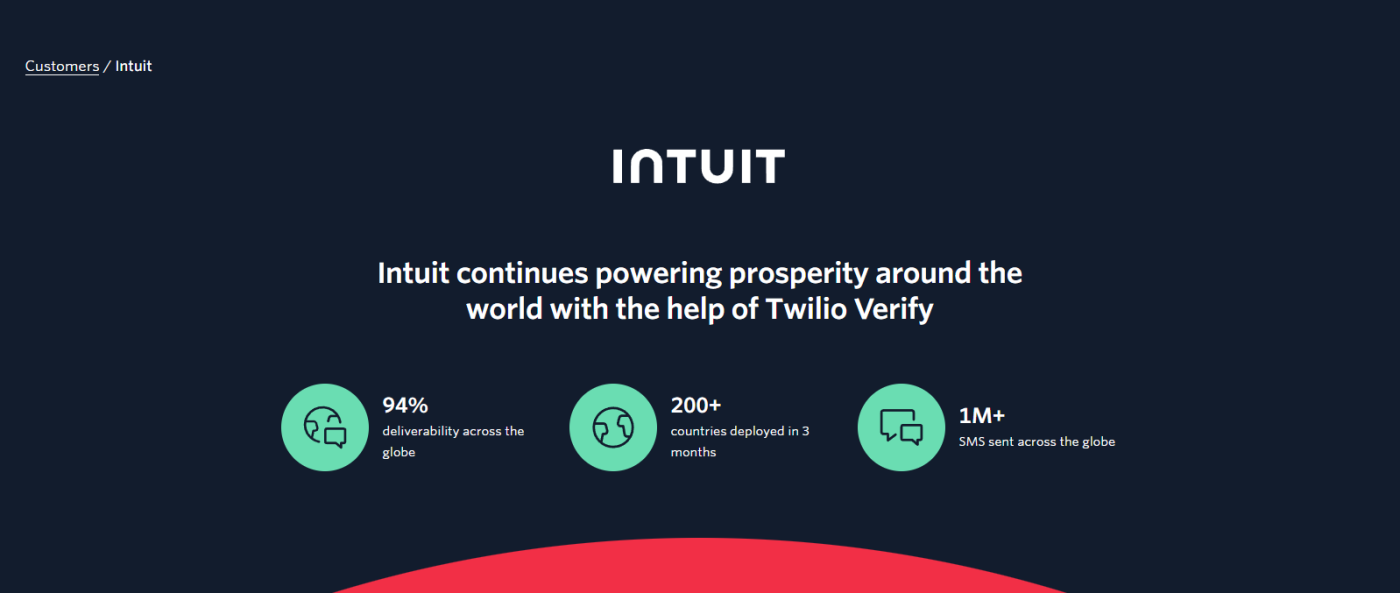
Twilio does an excellent job of delivering achievements at the very beginning of the case study and going into detail in this two-minute read. While there aren't many graphics, the way quotes from the Intuit team are implemented adds a certain flair to the study and breaks up the sections nicely.
It's simple, concise, and manages to fit a lot of information in easily digestible sections.
Takeaway: Make sure each section is long enough to inform but brief enough to avoid boring readers. Break down information for each section, and don't go into so much detail that you lose the reader halfway through.
13. Spotify and Salesforce
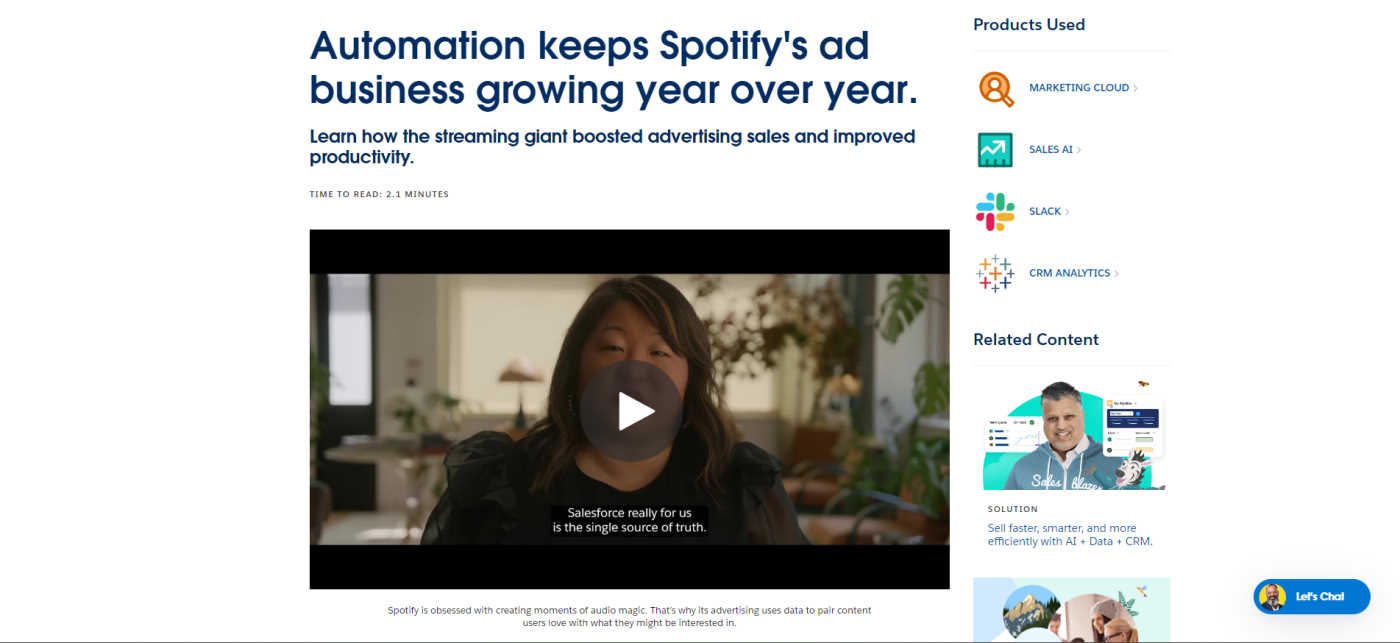
Salesforce created a video that accurately summarizes the key points of the case study. Beyond that, the page itself is very light on content, and sections are as short as one paragraph.
I especially like how information is broken down into "What you need to know," "Why it matters," and "What the difference looks like." I'm not ashamed of being spoon-fed information. When it's structured so well and so simply, it makes for an entertaining read.
Takeaway: Invest in videos that capture and promote your partnership with your case study subject. Video content plays a promotional role that extends beyond the case study in social media and marketing initiatives .
14. Benchling and Airtable
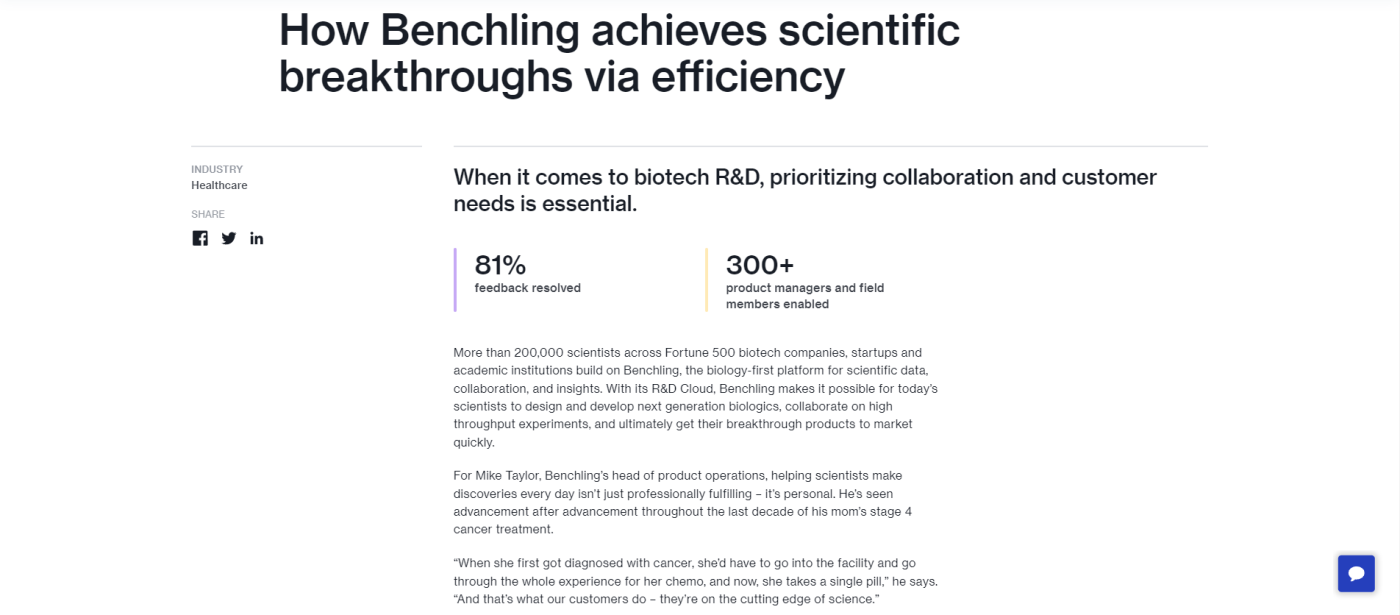
Benchling is an impressive entity in its own right. Biotech R&D and health care nuances go right over my head. But the research and digging I've been doing in the name of these burritos (case studies) revealed that these products are immensely complex.
And that's precisely why this case study deserves a read—it succeeds at explaining a complex project that readers outside the industry wouldn't know much about.
Takeaway: Simplify complex information, and walk readers through the company's operations and how your business helped streamline them.
15. Chipotle and Hubble
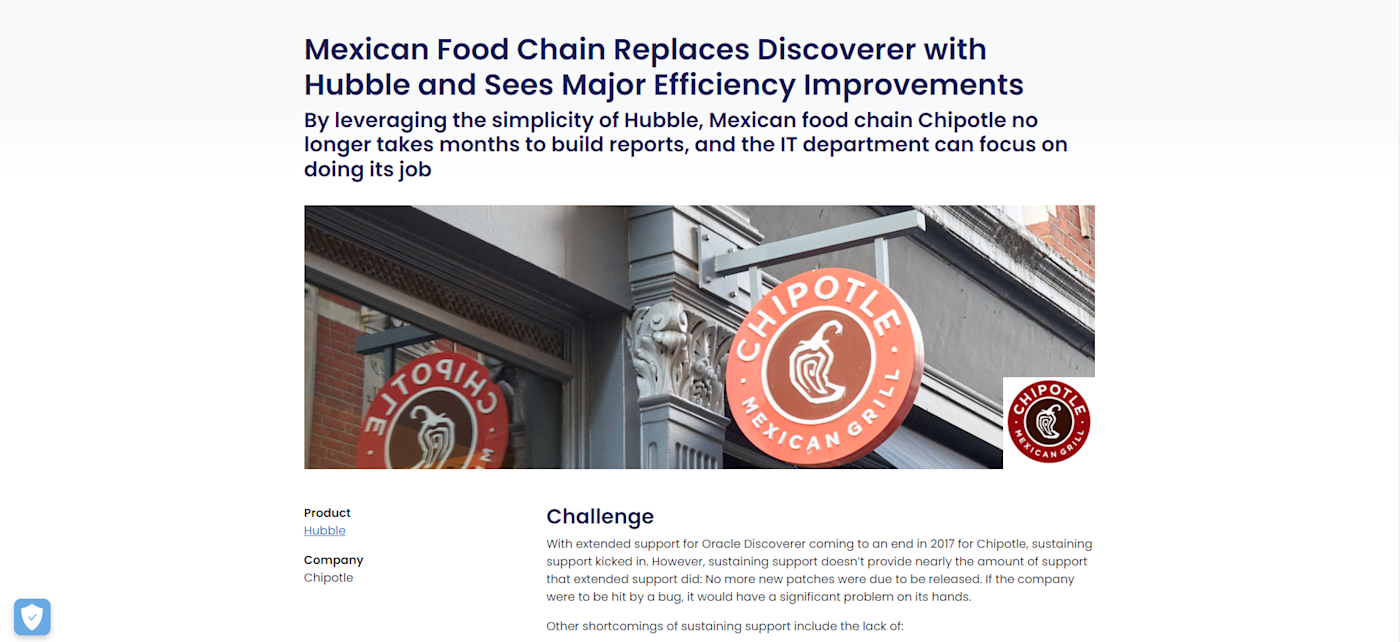
The concision of this case study is refreshing. It features two sections—the challenge and the solution—all in 316 words. This goes to show that your case study doesn't necessarily need to be a four-figure investment with video shoots and studio time.
Sometimes, the message is simple and short enough to convey in a handful of paragraphs.
Takeaway: Consider what you should include instead of what you can include. Assess the time, resources, and effort you're able and willing to invest in a case study, and choose which elements you want to include from there.
16. Hudl and Zapier

I may be biased, but I'm a big fan of seeing metrics and achievements represented in branded graphics. It can be a jarring experience to navigate a website, then visit a case study page and feel as though you've gone to a completely different website.
The Zapier format provides nuggets of high-level insights, milestones, and achievements, as well as the challenge, solution, and results. My favorite part of this case study is how it's supplemented with a blog post detailing how Hudl uses Zapier automation to build a seamless user experience.
The case study is essentially the summary, and the blog article is the detailed analysis that provides context beyond X achievement or Y goal.
Takeaway: Keep your case study concise and informative. Create other resources to provide context under your blog, media or press, and product pages.
3 case study templates
Now that you've had your fill of case studies (if that's possible), I've got just what you need: an infinite number of case studies, which you can create yourself with these case study templates.
Case study template 1
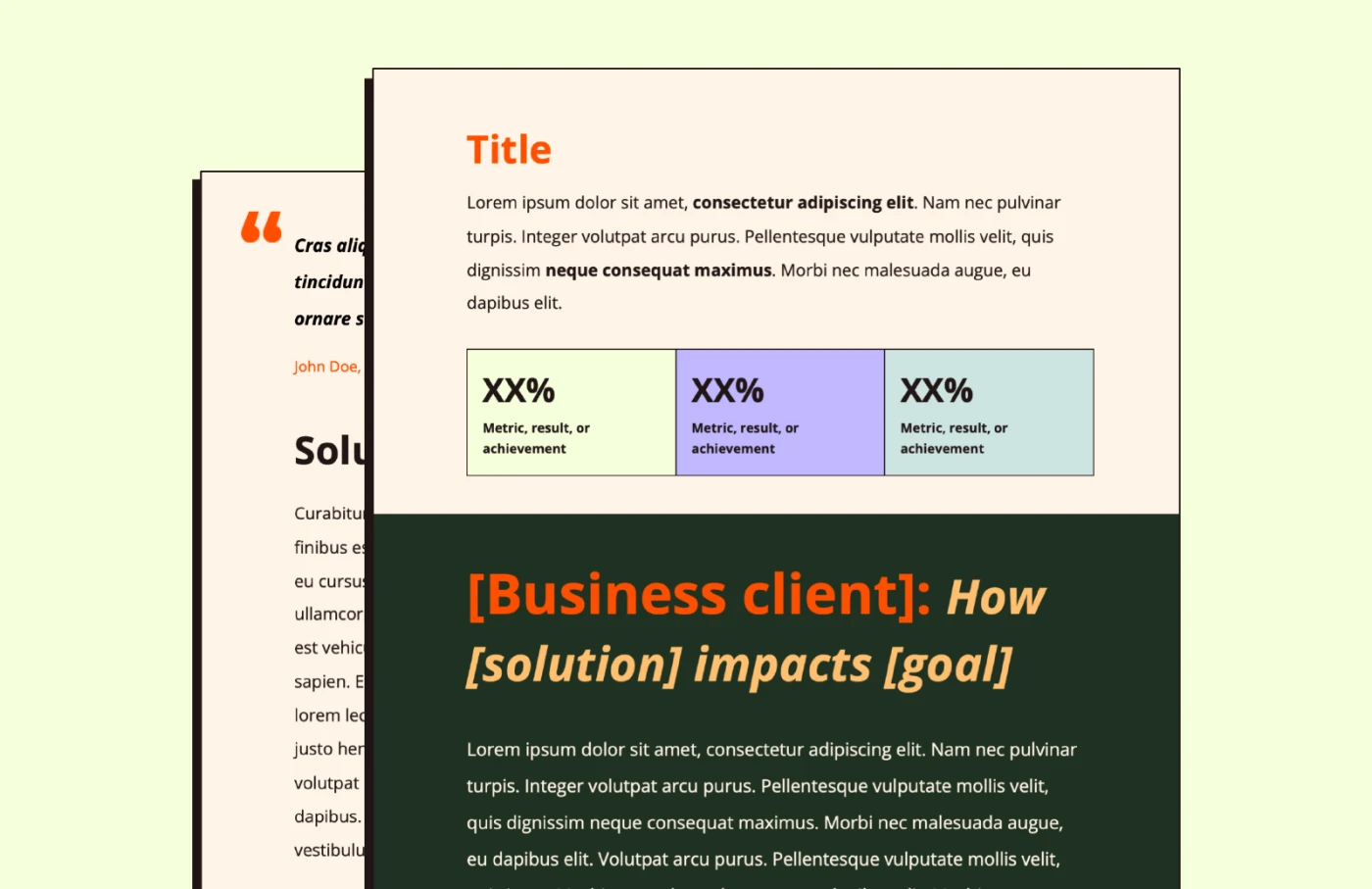
If you've got a quick hit of stats you want to show off, try this template. The opening section gives space for a short summary and three visually appealing stats you can highlight, followed by a headline and body where you can break the case study down more thoroughly. This one's pretty simple, with only sections for solutions and results, but you can easily continue the formatting to add more sections as needed.
Case study template 2
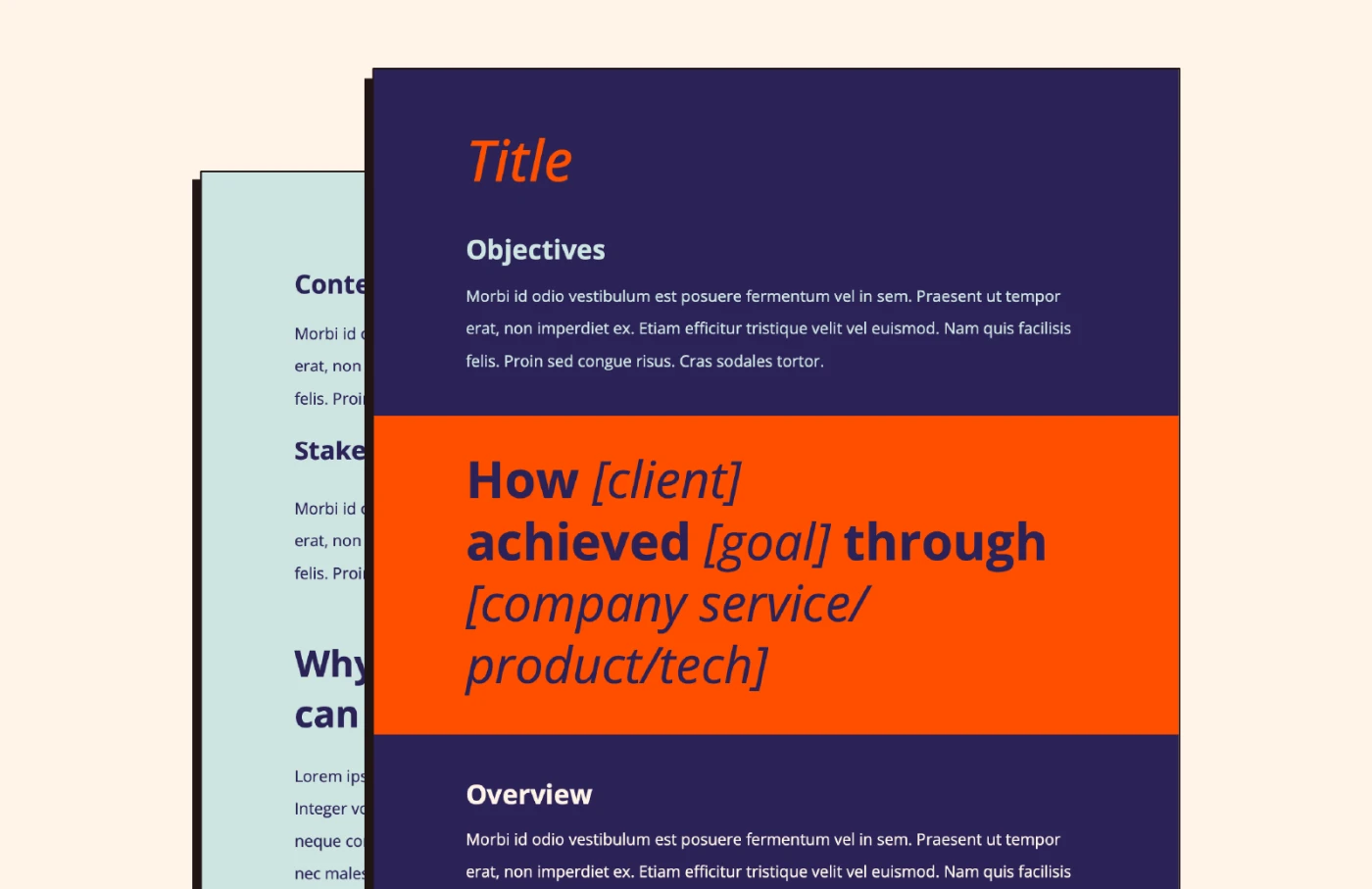
For a case study template with a little more detail, use this one. Opening with a striking cover page for a quick overview, this one goes on to include context, stakeholders, challenges, multiple quote callouts, and quick-hit stats.
Case study template 3
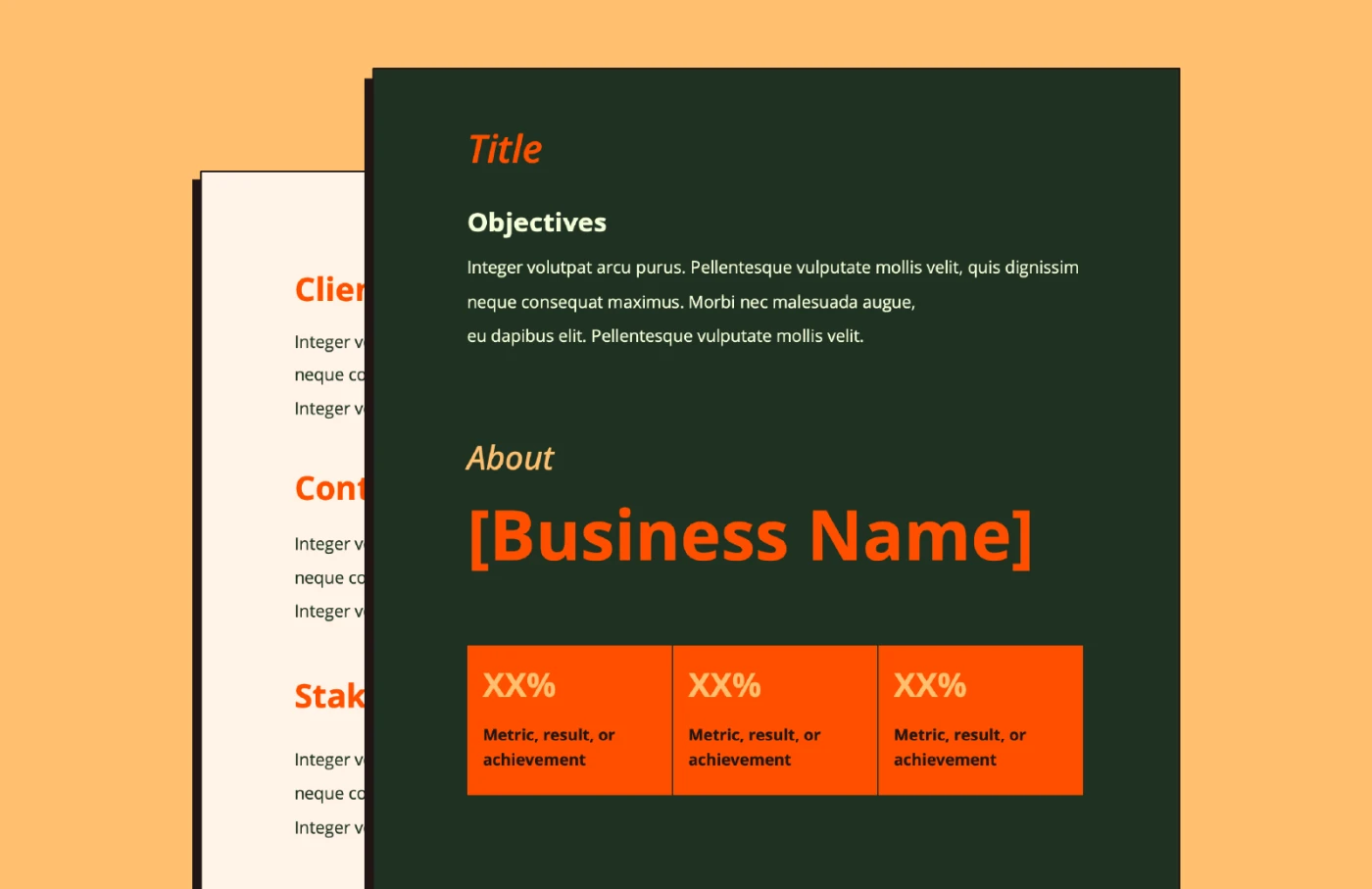
Whether you want a little structural variation or just like a nice dark green, this template has similar components to the last template but is designed to help tell a story. Move from the client overview through a description of your company before getting to the details of how you fixed said company's problems.
Tips for writing a case study
Examples are all well and good, but you don't learn how to make a burrito just by watching tutorials on YouTube without knowing what any of the ingredients are. You could , but it probably wouldn't be all that good.
Writing a good case study comes down to a mix of creativity, branding, and the capacity to invest in the project. With those details in mind, here are some case study tips to follow:
Have an objective: Define your objective by identifying the challenge, solution, and results. Assess your work with the client and focus on the most prominent wins. You're speaking to multiple businesses and industries through the case study, so make sure you know what you want to say to them.
Focus on persuasive data: Growth percentages and measurable results are your best friends. Extract your most compelling data and highlight it in your case study.
Use eye-grabbing graphics: Branded design goes a long way in accurately representing your brand and retaining readers as they review the study. Leverage unique and eye-catching graphics to keep readers engaged.
Simplify data presentation: Some industries are more complex than others, and sometimes, data can be difficult to understand at a glance. Make sure you present your data in the simplest way possible. Make it concise, informative, and easy to understand.
Use automation to drive results for your case study
A case study example is a source of inspiration you can leverage to determine how to best position your brand's work. Find your unique angle, and refine it over time to help your business stand out. Ask anyone: the best burrito in town doesn't just appear at the number one spot. They find their angle (usually the house sauce) and leverage it to stand out.
In fact, with the right technology, it can be refined to work better . Explore how Zapier's automation features can help drive results for your case study by making your case study a part of a developed workflow that creates a user journey through your website, your case studies, and into the pipeline.
Case study FAQ
Got your case study template? Great—it's time to gather the team for an awkward semi-vague data collection task. While you do that, here are some case study quick answers for you to skim through while you contemplate what to call your team meeting.
What is an example of a case study?
An example of a case study is when a software company analyzes its results from a client project and creates a webpage, presentation, or document that focuses on high-level results, challenges, and solutions in an attempt to showcase effectiveness and promote the software.
How do you write a case study?
To write a good case study, you should have an objective, identify persuasive and compelling data, leverage graphics, and simplify data. Case studies typically include an analysis of the challenge, solution, and results of the partnership.
What is the format of a case study?
While case studies don't have a set format, they're often portrayed as reports or essays that inform readers about the partnership and its results.
Related reading:
How Hudl uses automation to create a seamless user experience
How to make your case studies high-stakes—and why it matters
How experts write case studies that convert, not bore
Get productivity tips delivered straight to your inbox
We’ll email you 1-3 times per week—and never share your information.

Hachem Ramki
Hachem is a writer and digital marketer from Montreal. After graduating with a degree in English, Hachem spent seven years traveling around the world before moving to Canada. When he's not writing, he enjoys Basketball, Dungeons and Dragons, and playing music for friends and family.
- Content marketing
Related articles

8 essential tips for maximizing TikTok ads ROI
8 essential tips for maximizing TikTok ads...

The best marketing newsletters in 2024

11 Google Ads examples (and how to use their strategies)
11 Google Ads examples (and how to use their...

How will AI change SEO content production?
Improve your productivity automatically. Use Zapier to get your apps working together.


IMAGES
VIDEO
COMMENTS
Learn what a case study is, how to conduct one, and see examples of different types of case studies. A case study is a qualitative research method that involves an in-depth examination and analysis of a particular phenomenon or case.
Learn what a case study is, when to use it, and how to conduct one. Find out how to select a case, build a theoretical framework, collect data, and analyze the case.
Learn the definition, examples, types, and steps of a case study, a method of research that focuses on a single individual or group. Find out the pros and cons, sources and methods of case studies in psychology.
Learn what case study methodology is, how it can be used for different research purposes, and see some examples of qualitative, quantitative, and mixed methods case studies. Find out how to identify, plan, and conduct case studies in various disciplines and contexts.
Case study research consists of a detailed investigation, often with empirical material collected over a period of time from a well-defined case to provide an analysis of the context and processes involved in the phenomenon. ... Contact can be clarified with the example of authors' case study in which empirical material collection was done ...
Learn what case study research is, how to use it, and what types of case study designs exist. See examples of case studies from different disciplines and contexts.
A case study research paper examines a person, place, event, condition, phenomenon, or other type of subject of analysis in order to extrapolate key themes and results that help predict future trends, illuminate previously hidden issues that can be applied to practice, and/or provide a means for understanding an important research problem with greater clarity.
Step 1: Select a case to analyze. After you have developed your statement of the problem and research question, the first step in writing a case study is to select a case that is representative of the phenomenon being investigated or that provides an outlier. For example, if a researcher wants to explore the impact of COVID-19 on the ...
Learn what a case study is and how it is used in various fields to investigate a single person, group, event, or community. See examples of case studies in social sciences, business, healthcare, education, and law.
A case study is one of the most commonly used methodologies of social research. This article attempts to look into the various dimensions of a case study research strategy, the different epistemological strands which determine the particular case study type and approach adopted in the field, discusses the factors which can enhance the effectiveness of a case study research, and the debate ...
A Case study is: An in-depth research design that primarily uses a qualitative methodology but sometimes includes quantitative methodology. Used to examine an identifiable problem confirmed through research. Used to investigate an individual, group of people, organization, or event. Used to mostly answer "how" and "why" questions.
A case study is a research method where a specific instance, event, or situation is deeply examined to gain insights into real-world complexities. It involves detailed analysis of context, data, and variables to understand patterns, causes, and effects, often used in various disciplines for in-depth exploration.
Here are three examples of great case study content to get you started. Household Names: Adobe and The Home Depot. Adobe carried out an in-depth case study of a highly successful customer. Image Source: Adobe. The first part alone has enough to engage and intrigue the reader: A snappy headline; Three impressive takeaway stats; A customer ...
Case Study Sample Size. Typically, a case study has a sample of one (i.e., the bounded case, but note that sam - pling can also occur within the case), unless the research project is a multiple-case study. In a multiple-case study, having three to four distinct cases for comparison is probably the most cases that one can realistically handle.
A case study is a detailed study of a specific subject, such as a person, group, place, event, organisation, or phenomenon. Learn how to conduct a case study research design with qualitative and/or quantitative methods, and see examples of different types of case studies in various fields.
Learn how to write a case study with over 25 free samples and solutions for different fields, such as business, psychology, and education. See the structure, format, and tips for each case study example.
This means the normal rules of design apply. Use fonts, colors, and icons to create an interesting and visually appealing case study. In this case study example, we can see how multiple fonts have been used to help differentiate between the headers and content, as well as complementary colors and eye-catching icons.
Explain what you will examine in the case study. Write an overview of the field you're researching. Make a thesis statement and sum up the results of your observation in a maximum of 2 sentences. Background. Provide background information and the most relevant facts. Isolate the issues.
Case study examples. While templates are helpful, seeing a case study in action can also be a great way to learn. Here are some examples of how Adobe customers have experienced success. Juniper Networks. One example is the Adobe and Juniper Networks case study, which puts the reader in the customer's shoes.
For example, the case study quotes the social media manager and project manager's insights regarding team-wide communication and access before explaining in greater detail. Takeaway: Highlight pain points your business solves for its client, and explore that influence in greater detail. 3. EndeavourX and Figma.
We've put together 15 real-life case study examples to inspire you. These examples cover a variety of industries and formats, plus templates to inspire you. ... Video marketing, especially in case studies, works wonders. Research shows us that 42% of people prefer video testimonials because they show real customers with real success stories ...
The case study method is a research strategy that aims to gain an in-depth understanding of a specific phenomenon by collecting and analyzing specific data within its true context (Rebolj, 2013 ...
A case study psychology example could be that a researcher wants to study the onset of severe anxiety by a teenager following a natural disaster. The three most common types of case studies are ...
This study offers a comprehensive review of the current basic science and clinical literature concerning the diagnosis and treatment of spinal meningiomas in conjunction with illustrative case studies to emphasize up-to-date knowledge on molecular genetics, surgical resection, and alternative therapies.
A case study, serving as an illustration containing the necessary ingredients for a wider discussion, is the 2023 Vuelta de San Juan, but without loss of generality. It is shown that the new indicators offer some new viewpoint for distinguishing the ranking through the cumulative sums of the places of riders rather than their finishing times.